

Step-By-Step Guide: How to Build a Wooden Sailboat – Complete DIY Tutorial
Alex Morgan
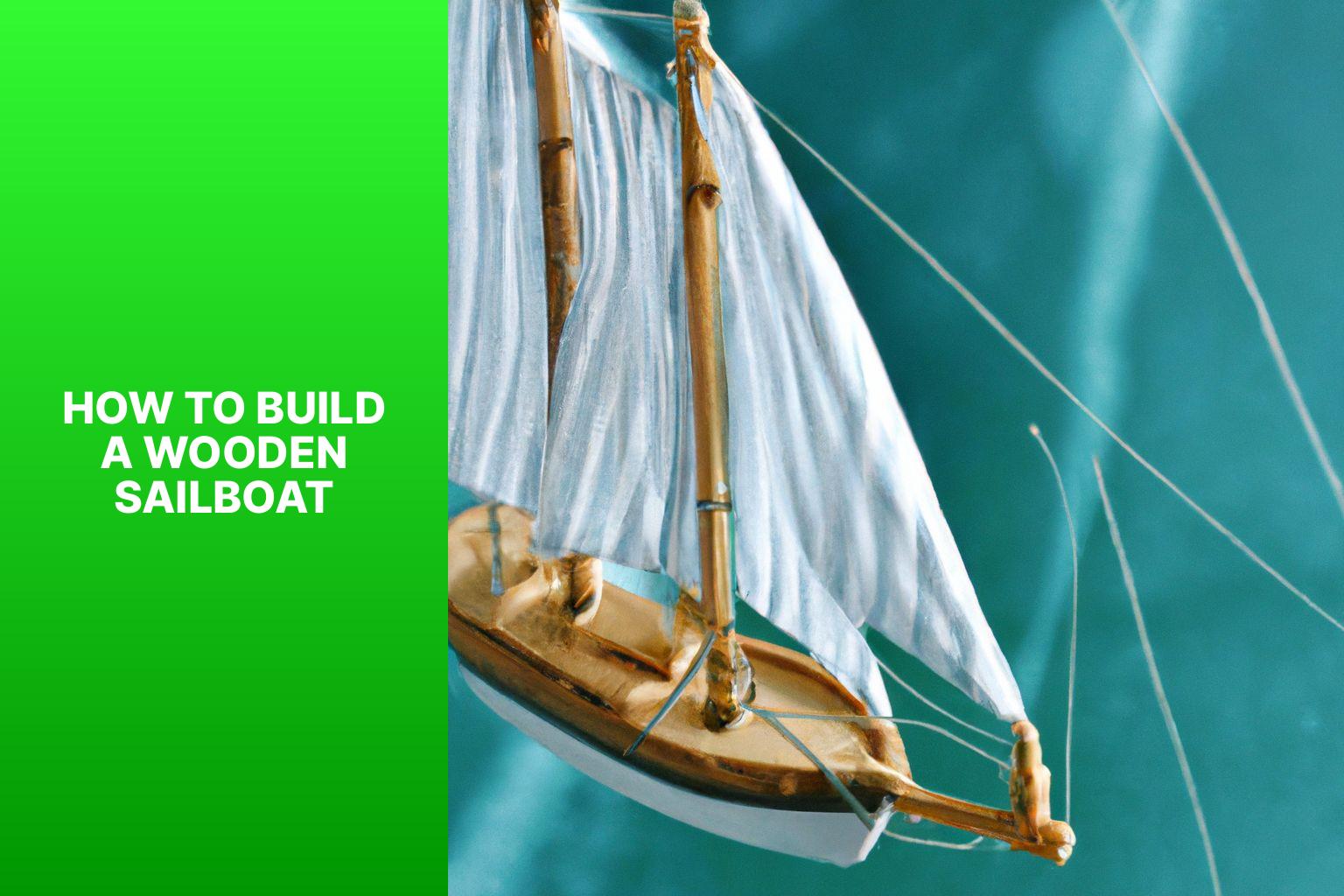
Building a wooden sailboat is a rewarding and fulfilling endeavor that allows you to create your own vessel for sailing adventures. Whether you’re a seasoned sailor or a woodworking enthusiast, constructing a wooden sailboat requires careful planning, attention to detail, and a love for craftsmanship. This comprehensive guide will take you through the step-by-step process of building a wooden sailboat, from choosing the right design and gathering the necessary materials to assembling the framework, building the deck and cabin, and installing the sails and rigging. We will also discuss the finishing touches and regular maintenance required to keep your wooden sailboat in optimal condition for years of enjoyment on the water. Let’s dive into the world of wooden sailboat construction and embark on this exciting journey together.
Key takeaways:
Key takeaway:
- Choosing the right design and plans is crucial: Research different sailboat designs and select suitable plans based on your skill level to ensure a successful project.
- Gather the necessary materials and tools: Pay attention to wood selection and preparation, as well as acquiring the tools and equipment needed for building your wooden sailboat.
- Attention to detail in the construction process is important: Prepare and assemble the framework carefully, focusing on lofting, laying out the keel, constructing the ribs, and the hull structure to ensure a sturdy and reliable sailboat.
Choosing the Right Design and Plans
When it comes to building a wooden sailboat, one of the crucial steps is choosing the right design and plans. In this section, we’ll take a deep dive into the world of sailboat designs and explore the vast array of options available. From researching different sailboat designs to selecting plans that match your skill level, we’ll guide you through the exciting process of bringing your wooden sailboat dream to life. So, hop aboard and let’s set sail on this exhilarating journey of craftsmanship and adventure.
Researching Different Sailboat Designs
When conducting research on sailboat designs, it is important to take into account a variety of factors in order to select the most suitable design. One of the primary considerations is whether you prefer a monohull or a multihull sailboat. Monohulls are more commonly found and offer superior performance when sailing upwind, whereas multihulls provide both stability and speed.
Another aspect to consider is your level of sailing experience. If you are a beginner, it is advisable to seek out designs that are easier to handle and forgiving. On the other hand, experienced sailors may gravitate towards performance-oriented designs that are ideal for racing or long-distance cruising.
It is crucial to think about how you intend to use the sailboat. Are you looking for a day sailer , a cruiser , or a racing boat ? Each design comes with its own set of distinctive features and characteristics.
Determining the appropriate size of the sailboat is another crucial step, which should be based on the number of people and activities you plan to have on board. You must also decide whether you prefer an open cockpit or an enclosed cabin .
To find the perfect sailboat design that aligns with your sailing goals and preferences, it is imperative to thoroughly research various options and take into consideration all of these factors. By doing so, you will be able to make an informed decision and select the ideal sailboat design.
Selecting Suitable Plans for Your Skill Level
When it comes to building a wooden sailboat, it is crucial to select suitable plans that match your skill level. This is important as it ensures that you have the necessary knowledge and expertise to effectively complete the construction. In order to help you with this, here is a table that outlines the different skill levels and the corresponding plans:
Choosing the right plans for your skill level is essential as it enables you to navigate the construction process smoothly, avoid any complications, and ultimately achieve the desired result. It is crucial to honestly evaluate your woodworking skills and then select plans that align with your abilities. Keep in mind that building a wooden sailboat demands patience , attention to detail , and a willingness to learn and improve your woodworking skills.
As a pro tip, if you are a beginner, it is advisable to start with simpler plans and gradually work your way up to more complex projects. This allows you to gain experience and confidence in your woodworking abilities over time. So always remember to select suitable plans for your skill level and enjoy the process of building your wooden sailboat.
Gathering the Necessary Materials and Tools
When it comes to building a wooden sailboat, gathering the necessary materials and tools is key . In this section, we’ll dive into the exciting world of selecting and preparing the right wood for your sailboat, as well as the essential tools and equipment you’ll need to bring your project to life. So, start sharpening your creativity and let’s sail away into the realm of wooden boat construction!
Wood Selection and Preparation
Incorporating the provided keywords naturally in the provided text:
1. Conduct research on the different types of wood used in boatbuilding, such as mahogany , teak , or oak . This will help you make an informed decision regarding the most suitable wood for your sailboat.
2. Determine the specific requirements of your sailboat design in order to guide your wood selection process. Each design may have different needs and preferences when it comes to the type of wood to be used.
3. Take into consideration the durability and resistance to rot of the wood options available. This is crucial to ensure the longevity and overall quality of your sailboat. Choosing a wood that can withstand exposure to water and other elements is essential.
4. Look for straight , dry , and defect-free wood. This will contribute to the structural integrity of your sailboat. Any defects or irregularities in the wood may compromise its strength and performance.
5. Calculate the amount of wood needed based on the specific design and measurements of your sailboat. This will help you estimate the quantity of wood required for the construction process.
6. Mill or cut the wood into the required dimensions and shapes as outlined in the sailboat design. This step is crucial for achieving the desired structure and appearance of your sailboat.
7. Prior to assembly, it is important to sand the wood surfaces thoroughly. This will remove any rough edges or splinters, ensuring a smooth and safe finish.
8. Apply a protective coating or sealant to the wood in order to prevent water damage. This will help preserve the wood and extend its lifespan .
By following these steps, you can ensure that the wood selected and prepared for your sailboat construction is suitable and of high quality.
Tools and Equipment Needed for the Project
When embarking on the construction of a wooden sailboat, it is crucial to have the appropriate tools and equipment to ensure successful completion.
To accurately measure and obtain precise alignment and dimensions, essential measuring tools such as a tape measure , combination square , and level are indispensable.
For shaping wooden components, cutting tools like a circular saw or table saw , jigsaw , and hand saw are necessary.
Joinery tools, including a chisel set , mallet or hammer , and drill with different-sized bits, are vital for smoothly joining parts together.
To achieve a polished finish, sanding and finishing tools such as sandpaper with varying grits, sanding blocks , and a random orbital sander are crucial.
Additionally, brushes and rollers are required for the application of finishes.
When it comes to safety, it is imperative to prioritize the use of safety goggles , ear protection , a dust mask , and work gloves to ensure personal protection during the construction process.
When selecting tools and equipment, it is essential to invest in high-quality items that are specifically designed for the tasks involved in wooden sailboat building.
By doing so, not only will efficiency be maximized, but the overall quality of the finished boat will also be greatly enhanced.
Preparing and Assembling the Framework
As we delve into the world of building a wooden sailboat, we now find ourselves in the exciting phase of preparing and assembling the framework. In this section, we’ll discover the essential steps that go into setting up the lofting and laying out the keel , as well as the intricacies of constructing the ribs and hull structure. Get ready to immerse yourself in the hands-on process of bringing this magnificent vessel to life!
Setting Up the Lofting and Laying Out the Keel
To properly set up the lofting and lay out the keel for a wooden sailboat, it is important to follow these steps in a systematic manner:
- Firstly, prepare the lofting area by clearing a large, flat space where the plans and measurements will be placed.
- Next, securely attach the keel stock to the lofting platform, making sure it is both level and aligned with the boat’s centerline.
- Using battens, rulers, and pencils, transfer the measurements and lines from the boat plans onto the lofting platform.
- Ensure the accuracy of the waterlines, buttock lines, and other reference lines on the lofting platform by drawing them according to the measurements provided in the boat plans.
- Utilizing the dimensions indicated in the plans, measure and mark the positions of the keel, stem, and transom on the lofting platform.
- Thoroughly examine and adjust all lines and measurements to guarantee their accuracy.
- Identify the locations where any additional frames, bulkheads, or structural elements will connect to the keel, by marking them accordingly.
- Prior to proceeding, double-check all marks and measurements to ensure their accuracy.
The process of setting up the lofting and laying out the keel is an integral step in the construction of a wooden sailboat. It serves as the foundation and reference points for the boat’s overall structure. It is crucial to pay close attention to detail and maintain accuracy throughout the build. By following these steps, you will be on your way to constructing your very own wooden sailboat.
Constructing the Ribs and Hull Structure
When constructing the ribs and hull structure of a wooden sailboat, follow these steps:
– Measure and cut the ribs: Use the plans as a guide to mark and cut the dimensions on the wood. Cut the ribs accurately.
– Attach the ribs to the keel: Position and attach the cut ribs evenly along the keel using marine epoxy and screws.
– Install chines and stringers: Attach the chines to the bottom edge of the boat and install the stringers along the sides for strength.
– Attach the planking: Cut and fit planks to cover the rib and stringer structure, securing them tightly.
– Reinforce the joints: Apply epoxy and fiberglass tape over the joints to strengthen the structure.
– Shape the hull: Use tools to shape and smooth the hull, paying attention to fairing for optimal hydrodynamics.
– Apply a protective finish: Coat the hull and ribs with marine-grade varnish or epoxy for durability.
– Perform a thorough inspection: Check for defects, cracks, or imperfections and make necessary repairs before moving forward.
The process of constructing wooden sailboats has evolved over time, combining traditional techniques with modern materials and tools. Craftsmanship, attention to detail, and an understanding of wood’s properties are still essential in constructing the ribs and hull structure. This blend of artistry and engineering ensures sailboats can withstand the demands of the sea while providing a smooth and enjoyable sailing experience.
Building the Deck and Cabin
Let’s dive into the exciting world of building a wooden sailboat! In this section, we’ll focus on the crucial element of constructing the deck and cabin. Get ready to explore the process of creating the deck framework and adding those essential interior features . From laying the foundation to crafting a cozy cabin space , we’ll uncover the key steps and considerations for bringing your wooden sailboat to life. So, grab your tools and let’s set sail on this exhilarating construction journey !
Creating the Deck Framework
When creating the deck framework for a wooden sailboat, follow these steps:
- Measure and mark the desired deck size and shape on the boat’s frame.
- Cut and shape the wooden planks or panels to match the marked measurements.
- Align the planks or panels horizontally across the frame, ensuring they are straight and evenly spaced.
- Secure the planks or panels to the frame using screws or nails, ensuring tight fastening.
- Add additional support beams or joists underneath the deck for added strength and stability.
- Sand the deck surface to create a smooth and even finish.
- Apply a weather-resistant sealant or paint to protect the deck from moisture and UV damage.
- Install necessary features or fixtures on the deck, such as hatches, cleats or railings.
Pro-tip: Enhance the deck’s strength and durability by adding epoxy or marine adhesive between the joints before securing the planks or panels.
Installing the Cabin and Interior Features
When building a wooden sailboat, it is important to pay attention to every step, including the installation of the cabin and interior features. To install these features, follow the following steps:
1. First, measure and cut the materials for the cabin walls, floor, and ceiling.
2. Next, securely fit the cabin walls in place.
3. Then, attach the floorboards to the cabin base using screws or nails.
4. Align and install the cabin ceiling.
5. If desired, add insulation for extra comfort.
6. Attach interior features such as cabinets, storage compartments, and seating areas.
7. Install windows and hatches to allow for natural light and ventilation.
8. Properly wire the cabin for electricity, ensuring that lights and outlets are installed and functioning.
9. Finish the interior by sanding and applying a protective coat of varnish or paint.
10. Ensure that all installations meet safety standards.
Precision and attention to detail are key when installing the cabin and interior features of a wooden sailboat. By carefully measuring, cutting, and fitting each component, you can ensure a secure fit. It is important to optimize the layout and functionality of the interior features to create a comfortable living space with ample storage. The addition of windows and hatches will enhance comfort and enjoyment by providing natural light and ventilation . If electricity is needed, proper wiring is essential to ensure necessary lighting and power outlets. Finishing the interior with a protective coat of varnish or paint will not only enhance aesthetics but also provide durability.
Remember, the goal is to create a cozy retreat for sailors, so it is important to put in the necessary effort to install the cabin and interior features correctly.
Installing the Sails and Rigging
Set sail with confidence as we dive into the exciting world of installing the sails and rigging for your wooden sailboat. Discover the key considerations in choosing the perfect sails and master the art of setting up and adjusting the rigging. With expert tips and tricks , this section will equip you with the knowledge to navigate the waters with ease and experience the thrill of sailing your wooden masterpiece .
Choosing the Right Sails
When choosing sails for your wooden sailboat, consider the following factors:
– Type of sailing: Determine if you plan to cruise , race , or do both. Different sails are designed for specific purposes.
– Boat size: The size of your sailboat determines the size and number of sails you need. Larger boats require bigger sails , while smaller boats may need fewer and smaller sails .
– Wind conditions: Consider the typical wind conditions in your sailing areas. Different sails perform better in light winds , heavy winds , or various wind conditions.
– Sail material: The material of the sails affects durability and performance. Material choices include Dacron , laminate , and nylon . Each material has different trade-offs between longevity, performance, and cost.
– Reefing options: If you sail in varied or unpredictable wind conditions, choose sails with reefing options. Reefing allows you to adjust the sail area for stronger winds, improving control and safety.
– Manufacturer reputation: Research sail manufacturers for their reputation and reliability. Read reviews, seek recommendations, and consider warranty and customer support.
By considering these factors, you can make an informed decision when choosing sails for your wooden sailboat. Remember, the right sails greatly impact your sailing experience, so take your time and choose wisely.
Setting Up and Adjusting the Rigging
When setting up and adjusting the rigging of a wooden sailboat, it is important to follow these steps to ensure proper and safe rigging.
To start, attach the mast to the deck using a mast step or mast partner for stability and support. This will provide the foundation for the rigging.
Next, secure the standing rigging , which includes the shrouds and stays , to the mast. This will help distribute the forces from the sails and ensure the stability of the mast.
Connect the forestay to the bow of the sailboat. This will keep the mast in line and control the position of the headsail.
To counteract forces from the headsail and maintain rigging tension, attach the backstay to the stern of the boat.
Use turnbuckles or rigging screws to adjust the tension in the standing rigging. This will ensure proper alignment and support of the mast.
Install the running rigging , including halyards and sheets , to control the position and tension of the sails.
Before and during sailing, it is important to regularly check the tension in the rigging to ensure performance and safety.
Make any necessary adjustments to the rigging during sailing in order to optimize the shape of the sails and enhance the performance of the boat.
By following these steps, you will be able to properly set up and adjust the rigging of your wooden sailboat, allowing for safe and enjoyable sailing experiences.
Finishing Touches and Maintenance
When it comes to completing your wooden sailboat and keeping it in top shape, this section has got you covered. We’ll dive into the art of applying exquisite finishes to the hull and deck, giving your sailboat a stunning appearance. And don’t worry, we won’t neglect the nitty-gritty details of regular maintenance and care, ensuring your wooden vessel remains seaworthy for years to come. So, let’s get ready to add those finishing touches and keep your sailboat sailing smoothly !
Applying Finishes to the Hull and Deck
When building a wooden sailboat, applying finishes to the hull and deck is crucial for durability and aesthetic appeal. Here are the steps to follow:
1. Prepare the surfaces: Sand down rough spots, fill in cracks and imperfections, and ensure a smooth and clean surface.
2. Choose the right finish: Consider the type of wood and desired look. Varnish provides a glossy and traditional appearance, while paint offers different colors and styles.
3. Apply the primer: Enhance adherence and create an even surface for the final coat by applying a primer.
4. Apply the finish: Use a brush or roller to apply the chosen finish coat to the hull and deck. Follow the manufacturer’s instructions for drying times and application techniques.
5. Allow for drying and curing: Follow the manufacturer’s instructions for drying and curing to ensure the finish is fully set and provides maximum protection.
6. Inspect and touch up: After drying, inspect the hull and deck for missed spots or imperfections. Touch up any areas that require additional finish for a seamless and polished look.
By following these steps and applying finishes properly, you can protect and enhance the hull and deck of your wooden sailboat, ensuring it looks beautiful and lasts for many years.
Regular Maintenance and Care for Your Wooden Sailboat
Regular maintenance and care for your wooden sailboat is crucial for its longevity and performance. Here are the steps to follow:
1. Inspect the hull and deck for damage like cracks or rot. Promptly repair any issues to prevent further damage.
2. Clean the boat regularly with mild detergent and freshwater to remove dirt, salt, and grime that can accumulate over time.
3. Apply a protective coating to the hull and deck using marine-grade varnish or paint to prevent water penetration and protect against UV damage.
4. Check the rigging and sails for wear or damage. Replace worn-out lines or rigging components for safe sailing.
5. Inspect wooden components such as the mast, boom, and rudder for rot or decay. Replace or repair as necessary to maintain structural integrity.
6. Keep the interior of the sailboat clean and dry to prevent mold and mildew growth. Use a dehumidifier if needed.
7. Regularly check and maintain the boat’s systems , including electrical, plumbing, and navigation equipment. Address any issues promptly.
8. Store the wooden sailboat in a suitable location, such as a covered boat dock or boatyard, when not in use. Protect it from extreme weather conditions.
Pro-tip: Establish a regular maintenance schedule and keep a detailed record of all maintenance and repairs. This will help you stay organized and ensure your wooden sailboat remains in optimal condition.
Some Facts About How To Build A Wooden Sailboat:
- ✅ Building a wooden sailboat can take approximately 100 hours over a span of 3 months. (Source: Instructables)
- ✅ A wooden sailboat can cost around $1,000 to build. (Source: Instructables)
- ✅ The boat is typically built from 4×8 sheets of plywood and measures 8 feet in length. (Source: Instructables)
- ✅ Various tools such as a pull-saw, table saw, router, sander, and drill are needed for building a wooden sailboat. (Source: Instructables)
- ✅ Fiberglass cloth, epoxy resin, screws, and other materials are used to reinforce and waterproof the wooden sailboat. (Source: Instructables)
Frequently Asked Questions
1. how long does it take to build a wooden sailboat.
Building a wooden sailboat typically takes about 100 hours spread over approximately 3 months.
2. What materials are needed to build a wooden sailboat?
To build a wooden sailboat, you will need 4×8 sheets of plywood, epoxy resin, oak plywood, various tools (such as a pull-saw, table saw, router, etc.), fiberglass cloth, screws, fasteners, and other supplies like glue, clamps, and mixing cups.
3. How much does it cost to build a wooden sailboat?
The estimated cost of building a wooden sailboat is around $1,000, including the materials and tools needed for the project.
4. Can I learn to build a wooden sailboat if I have no prior experience?
Yes, building skills can be learned gradually, and mistakes can be avoided along the way. With patience and guidance from boat building plans, even beginners can successfully build a wooden sailboat.
5. How long is the wooden sailboat described in the reference?
The wooden sailboat described in the reference is an 8-foot long pram, featuring classic lines and made from 4×8 sheets of plywood.
6. Can I launch the wooden sailboat in any body of water?
Yes, the wooden sailboat is designed to be light enough to fit in a small pickup truck or be rolled to a local lake on a dolly, making it suitable for various bodies of water.
About the author
Leave a Reply Cancel reply
Your email address will not be published. Required fields are marked *
Save my name, email, and website in this browser for the next time I comment.
Latest posts

The history of sailing – from ancient times to modern adventures
History of Sailing Sailing is a time-honored tradition that has evolved over millennia, from its humble beginnings as a means of transportation to a beloved modern-day recreational activity. The history of sailing is a fascinating journey that spans cultures and centuries, rich in innovation and adventure. In this article, we’ll explore the remarkable evolution of…

Sailing Solo: Adventures and Challenges of Single-Handed Sailing
Solo Sailing Sailing has always been a pursuit of freedom, adventure, and self-discovery. While sailing with a crew is a fantastic experience, there’s a unique allure to sailing solo – just you, the wind, and the open sea. Single-handed sailing, as it’s often called, is a journey of self-reliance, resilience, and the ultimate test of…

Sustainable Sailing: Eco-Friendly Practices on the boat
Eco Friendly Sailing Sailing is an exhilarating and timeless way to explore the beauty of the open water, but it’s important to remember that our oceans and environment need our protection. Sustainable sailing, which involves eco-friendly practices and mindful decision-making, allows sailors to enjoy their adventures while minimizing their impact on the environment. In this…

- Plans & Kits

- Qty in Cart
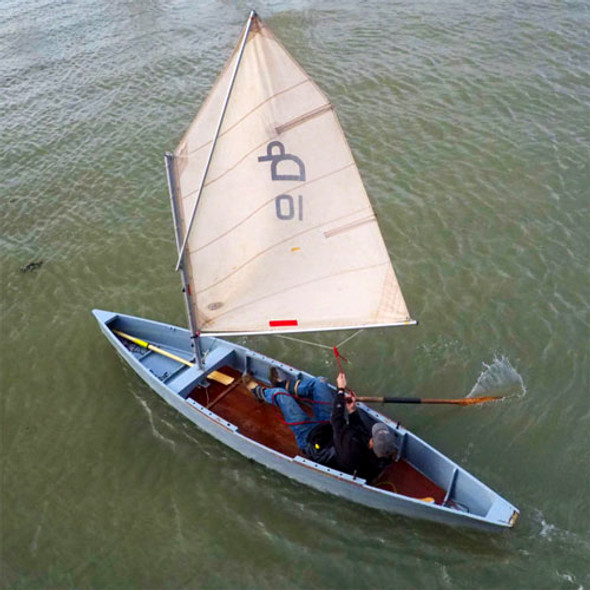
West Mersea Duck Punt PDF Free Plans

Making Hand Screw Clamps Free Instructions

Tape & Glue Process Free Instructions
Lisa b good - free plans.
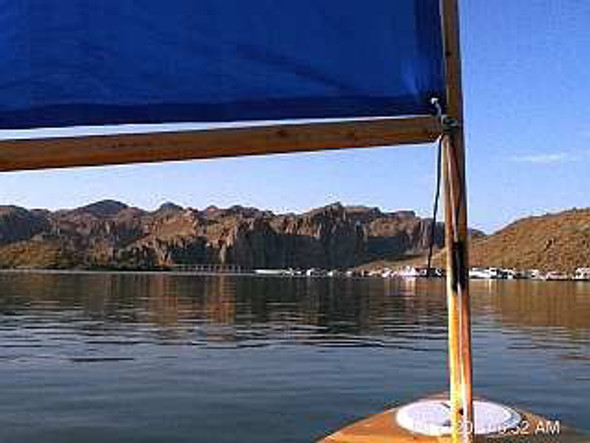
Folding Mast & Boom Free Plans PDF
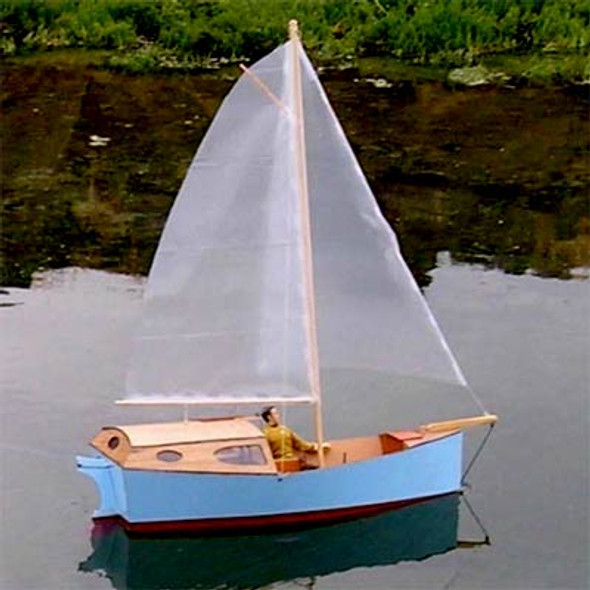
Slipper PDF
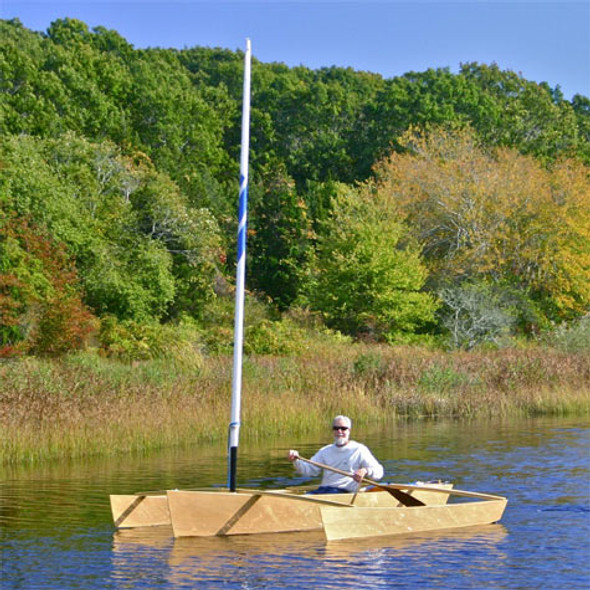
Drifter 12L Free Plans
Wanigan (free plans).
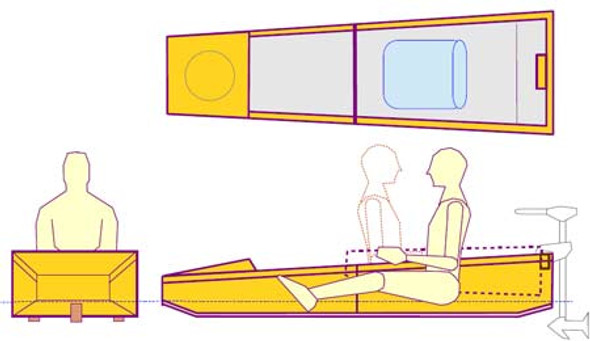
1 Sheet Wedge Plans PDF
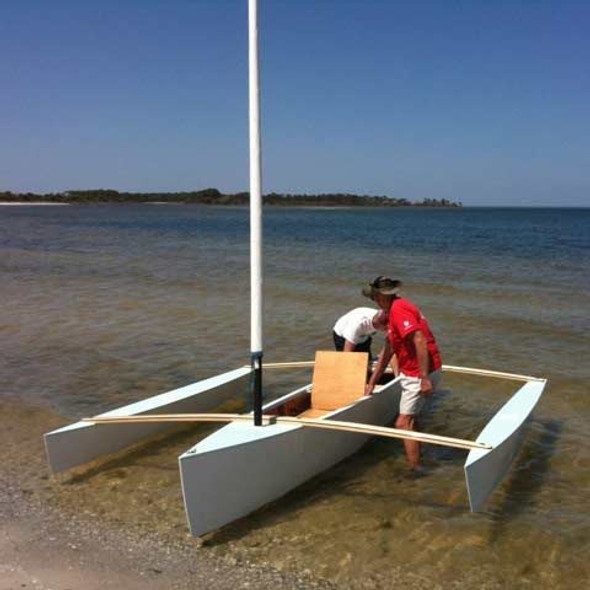
Drifter 12 Free Plans

Mouse Free Plans
Little bretton free plans.
- Total: items /
- Add all to cart
Adding your products to cart

- About Modern Wooden Boats
- Tips & tricks
- What’s inside a boat plan ?

Idea 21 sportboat
The development of the family of small offshore capable sailboat plans : chined hull for the highest stability, vertical lifting keel, trailerable, suitable for club racing or cruising (two interior versions) , plywood and epoxy hull with the radius chine system, sparkling performances while sailing and reasonable interiors for coastal cruising.
First boat launched : read the first impressions here
Idea 21 small sailboat plan is the latest development of my family of small plywood & epoxy sailboats plans for homebuilders : it was quite a time since i was thinking of an evolution of her smaller 19 footer sister, so i finally take the decision to publish this new plan. the goals of this plan is simple: add interior volume, simplify the work for homebuilders switching to a complete plywood & epoxy radius chine hull, enhance slightly the sparkling performances of idea 19, keeping the sailboat very balanced and suited for sailors ranging from enthusiast beginners to experienced seamen., first boat launched and several other boats in building stage make idea21 the most sparkling project on our catalogue, hull: chined hull on a small light sailboat has a simple reason to exist: it gives more stability to the sailboat when heeled, much more than a round hull similar sailboat. i managed to keep a very low wetted area of the unheeled hull, in order to achieve a good pace in light air and avoid excessive drag. stern sections are quite flat to gain speed downwind (idea 19 has been clocked with speed steadily in excess of 15 knots)., bow sections: experiences on racers showed that “knife-blade” bows may give you less resistance, but the price to pay is high in terms of buried bow sailing downwind, so i decide to provide this plan a large u-shaped section on the bow ; sails provide the sailboat plenty of power to defeat the small amount of added drag., sailplan: i have a very good starting point with idea 19, so we’re doing small adjustments and no revolutions: square top mainsail, 7/8 fractional rig , very wide single swept spreaders, no backstay, deck stepped mast with sturdy section, 110 % j jib, code zero, jennaker hoisted on swinging retractable bowsprit, and a good amount of sail area., keel and ballast: idea21 have a solid hard wood cored & unidirectional glass epoxy laminated lifting keel, with a naca optimised profile and a low resistance hydrodynamical shaped 280 kg lead bulb bolted on the keel tip; it can be made by a homebuilder, no need for professional welder; the fin area is on the low side, speed will help generating the required lift without adding too much drag. keel case is in 20 mm thickness plywood and epoxy laminated glass reinforcements, and it’s perfectly waterproof while sailing., full lifting keel version : after a request from a builder, idea 21 cruise is available in a version featuring an integral watertight keel case running form hull bottom to cabin top panels, this feature called flk (full lifting keel) will allow the boat to sail with keel partially raised or to motor with keel totally up, a good option if you sail in shallow waters frequently., cockpit: was one of the strongest point in idea19, we simply keep the same arrangement and dimensions, so we have a really huge area for the crew and a simple and sturdy building in plywood panels epoxy glued on a structure of bulkheads and stringers., interiors: here i focussed on several upgrades; i decided to split the project in two versions (so two different sets of plans, you have to specify on order), “sport cruise” or “racing” ; both versions have 4 berths, a classic v berth on bow and two quarter berth after; in the cruising version cabin is 55 cm longer, giving wider interiors, enough room for a separate toilette and more comfortable after berths ; in the racing version we have a marine toilet (there’s room for a jabsco compact one) under the bow v-berth; cabin height is 1.65 m in both versions. interiors plywood panels are detailed on plans., taking advantage form the first season of sailing, i can now say that i strongly advice the cruise version as long as you are not going to run a sailing school, thus needing extra space in the cockpit., wooden rig: starting form summer 2019 we deliver two extra drawings with the plans, both for race and cruise version, describing how to build a wooden rig suited for this boat. keep your budget low at the price of a small extra weight , how to build the boat: we chose the plywood & epoxy resin “radius chine” system, as for petrel 28 and hirundo 750, so the hull planking is in okume marine grade plywood ; planking the hull is quite fast , and the internal structure of the boat is made by plywood bulkheads, floors and solid wood longitudinal stringers, all glued with epoxy and strengthened with epoxy laminated glass tape, assembled on a cheap wood scaffold, keeping the hull light, sturdy and quite easy to build for homebuilders ; the goal is to keep the total weight of the 19 footer, raising the ballast fraction of the sailboat at the same time. here are a couple of pictures of the first planked hull perfectly showing the radius chine planking system.
a HUGE Thanks to Nils Theurer ([email protected]) for the awesome pictures taken during the first sea trials

Plans availability: Plans are available in italian and english. Plans are available in imperial units upon request (send me a mail before purchase).
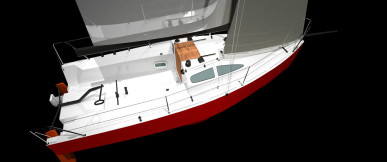
By continuing to use the site, you agree to the use of cookies. more information Accept
The cookie settings on this website are set to "allow cookies" to give you the best browsing experience possible. If you continue to use this website without changing your cookie settings or you click "Accept" below then you are consenting to this.
RETURN TO HOME PAGE
This Is the Easiest DIY Boat-Building Method We’ve Ever Seen
And the guy who discovered it is sharing all of his secrets.
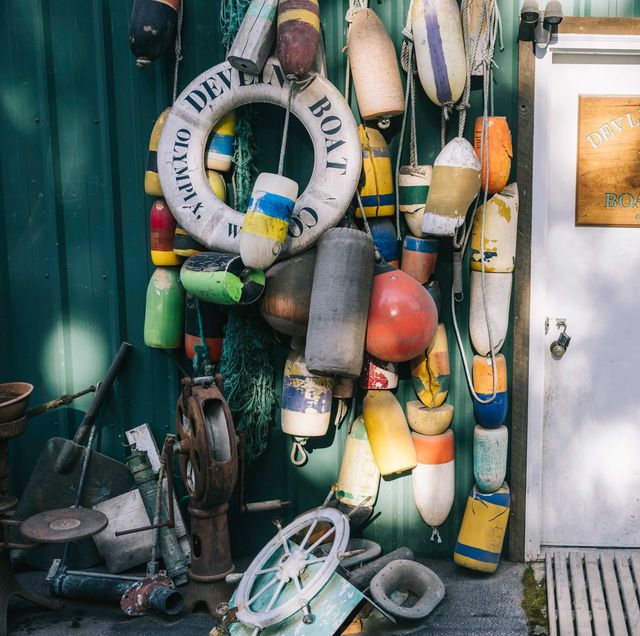
In the summer of 1974, Sam Devlin was working on a tugboat in Alaska when he read the first issue of Wooden Boat Magazine . He was immediately entranced. “I couldn’t shake the image of that wooden boat from my head,” Devlin says. “I can even see it today, almost five decades later.” Devlin had loved boats from a young age and had worked on fiberglass boats in the past, but the process lacked creativity, he says, and didn’t challenge him. This wooden boat, though, was something different.
A natural craftsman, Devlin believed wooden boatbuilding was a career he could be proud of. He leaned into the idea of making vessels that were both beautiful and functional—something that would last. Physical labor suited his strong, tall frame. And as a child of the ’60s, someone who came of age post-Vietnam, he felt the freedom to draw his own roadmap and forgo a traditional career.
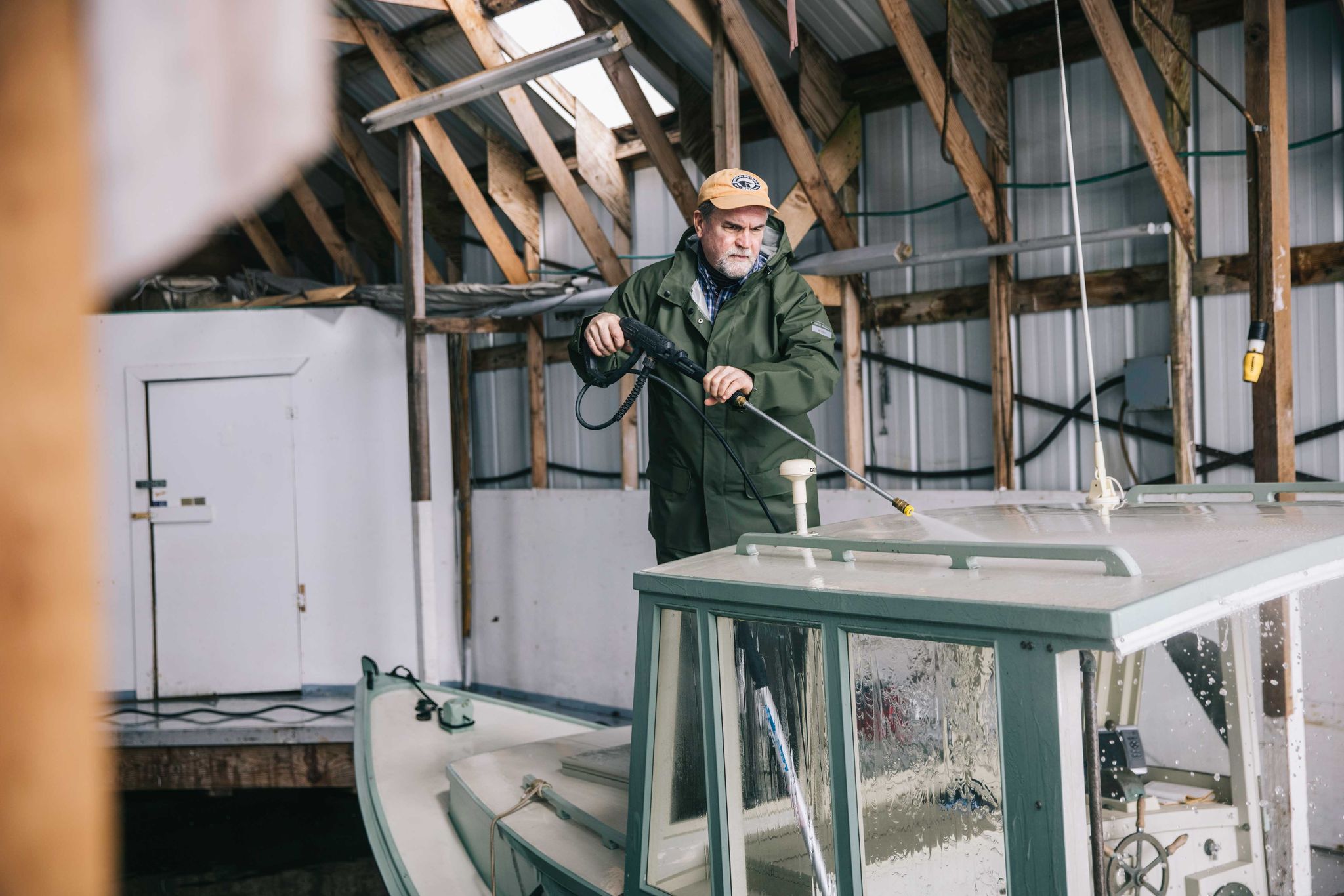
However, the wooden boat revival had just begun, and very few builders were sharing their processes. Devlin had to come up with his own from scratch. Starting in 1977 with hand drawings and small, to-scale models, Devlin created hull shapes that looked viable for small sail and motorboats. But one part stumped him: how to fuse the panels together.
Nevertheless, he forged ahead. “My dad agreed to buy the materials if I would build him a boat,” he says. Cutting the hull panels was the easy part. But they needed a method to attach them together. “We looked around the shop and saw baling wire and pliers, and two hours later we had the boat stitched together and looking like the shape we wanted. That was the eureka moment,” Devlin says. He had stumbled upon the stitch-and-glue method.
The stitch-and-glue method is a simple boat building technique popularized in the 1960s that creates a solid, one-piece hull, unlike most other wooden boats, which start with frames and bulkheads and build the hull on top. Using marine plywood panels stitched together with electric fence wire and sealed with epoxy resin, the process eliminates the need for frames or ribs, making it a simpler, faster construction. Stitch-and-glue doesn’t require expensive molds like fiberglass, and can be maintained over the long term, perfect for DIY builders.
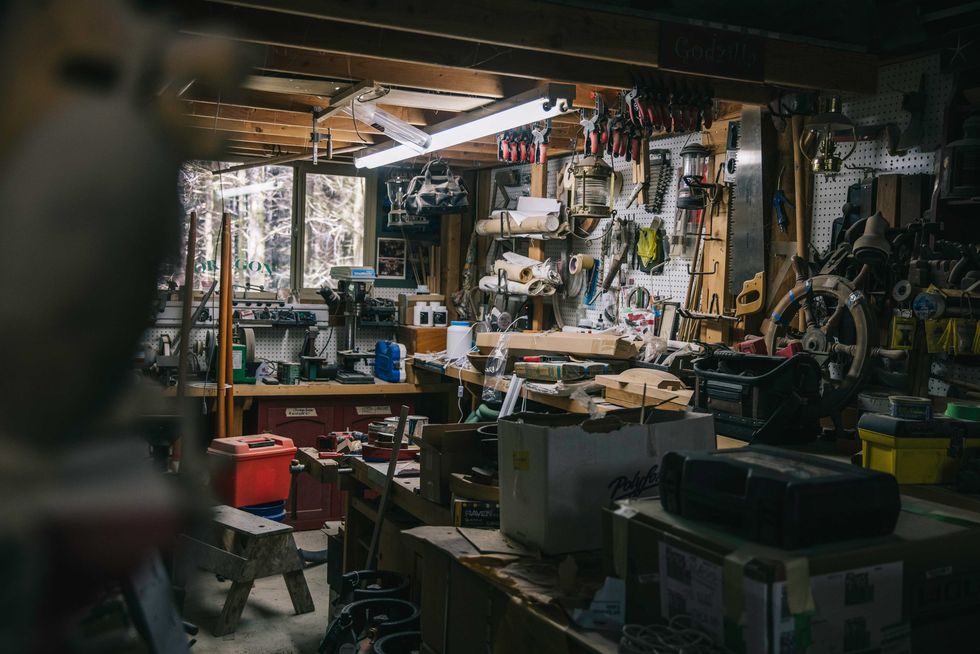
Devlin and his father continued to tinker with the shape and construction of their boat. A few days later they had a functional skiff. It wasn’t perfect, but it showed the stitch-and-glue process was more than viable—it had clear advantages over other boatbuilding methods.
Stitch and glue, generally speaking, has a remarkable ability to adapt. Without high tooling costs like most other boatbuilding mediums, it’s more accessible to more builders, which makes for rapid idea evolution and pervasion about the method. “With low barriers to entry from an experience side, we learned a lot quickly,” Devlin says. They learned that if they cheated on the grade of plywood, they would be sacrificing the integrity of the whole boat. They learned to use epoxy resins because they would seal stronger than more popular polyester resins. And moreover, they learned the process, the best order of operations, and how unique it was to quickly go from an idea to an actual, working boat.
Less than a year after finishing his first boat, Devlin embraced boatbuilding as a full-fledged career. Research led him to builders making small boats in England and New Zealand that used a method similar to the one he had devised with his dad, but not at the same scale or complexity he envisioned.
From there, he focused on improving the process. “We needed to nurture the method, testing the parameters and not constraining it with patents,” Devlin says. “My goal from the beginning was to proliferate the knowledge as much as possible and keep persisting and developing my own skills as a designer and builder.

“Most people didn’t see the potential for boats over 15 or 20 feet with stitch-and-glue, but I didn’t believe in that limitation. I hung my boatbuilding shingle on the door of my shop at the time in Eugene, Oregon, and I got my business started in 1978 with 25- and 30-foot boats.” Devlin’s business has grown since then, adding members to his team, expanding his shop, and refining his process. Today he works on a variety of wooden boats, and currently is putting the finishing touches on a 40-foot ocean-going catamaran.
The biggest advancement in the stitch-and-glue method in the past decades has been computers replacing hand drawings. Using 3D modeling and CNC machines to cut out shapes, the panels of the boat are more accurate and easier to work with during assembly. This also allows boat designers like Devlin to ship kits to home builders with precut panels to assemble using their own tools.
In 2012 Devlin received the Lifetime Achievement in Boatbuilding and Design award by the Wooden Boat Foundation and Wooden Boat Magazine , after designing and building over 400 boats (ranging from 7 to 65 feet) with the stitch and glue method, which he helped improve and bring to the mainstream. To this day Devlin is still building boats, from his facility in Olympia, Washington. Here are his tips for making your own.
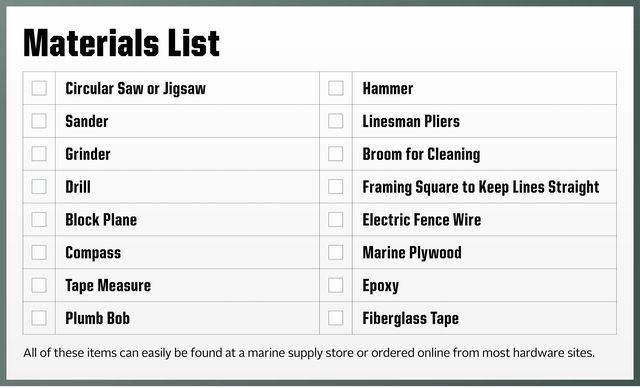
25 Steps to Building Your Own Stitch-and-Glue Boat
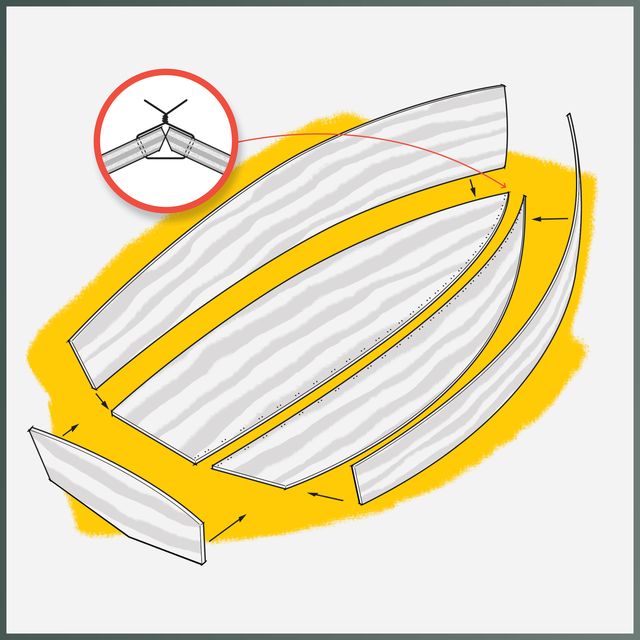
1. | Procure a set of plans, or scaled drawings of what you’re going to create. Devlin creates plans for hundreds of DIYers, detailing the peel shapes and all the materials you’ll need.
2 | If your boat is longer than 8 feet, edge-join the marine plywood panels end to end (called scarfing). If using a kit, the kit manufacturer will provide wave-to-keyhole type indexing to the ends of the panels that will help allow them to be joined.
3 | If you have a CNC router, use it to cut the panels to size (there are usually 5 to 8 for a small, simple boat). Skip to step 14.
4 | If you don’t have access to a CNC router, draw lines across the width of the panel at right angles to the long edge of the plywood, 1 foot apart.
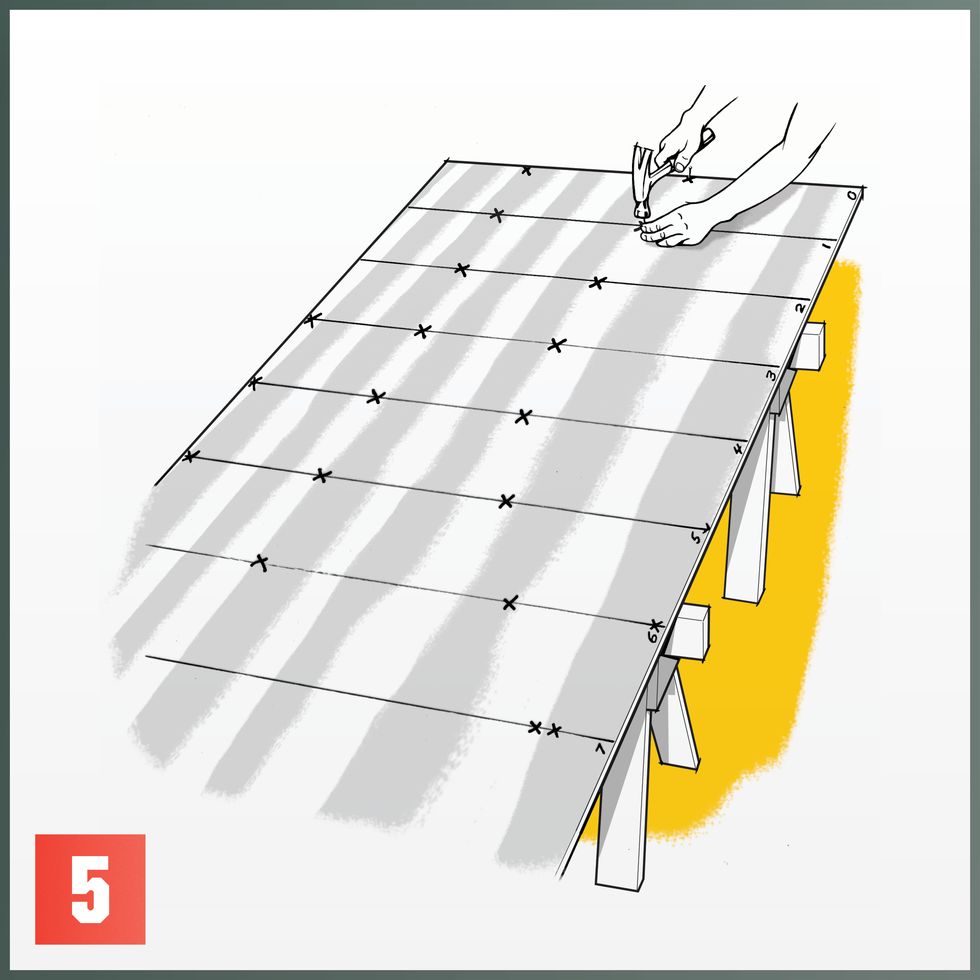
5 | Make marks at the bisects at each line, as shown on the plans, then hammer small brad-type nails (“fence posts”) partially into the plywood at each of those intersections.
6 | Draw smooth curves between these fence posts using a flexible wooden batten to span smoothly between each of the fence posts. When complete, remove the nails.
7 | Saw the panels out, leaving about 1/8 inch extra plywood overhang so you can see the line you drew.
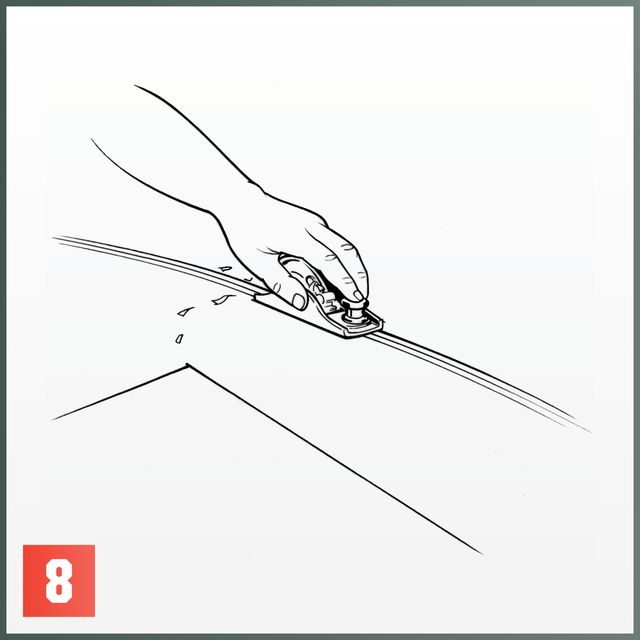
8 | Take both pieces and use a block plane to even them out so they’re symmetrical, smoothing the cutting lines out to the pencil line marks made previously.
9 | Do this for all of the panels of the boat, which together will make up the entire hull.
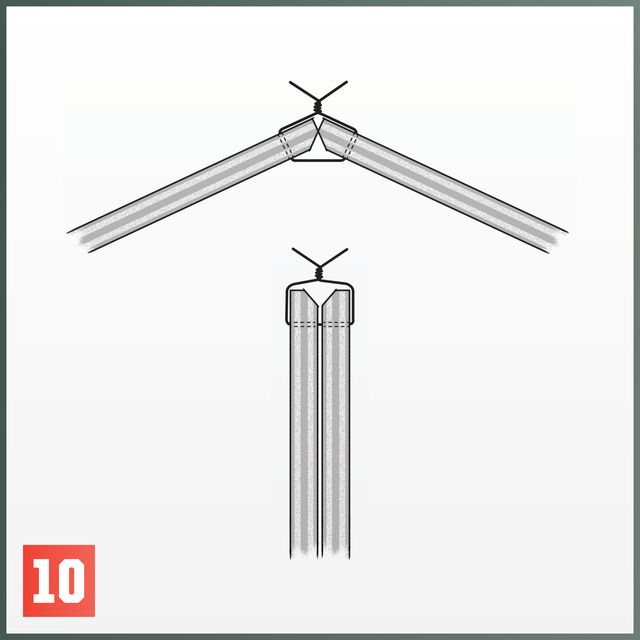
10 | Use a block plane to knock 45-degree bevels on half the thickness of the panel, on the inside surfaces (where it will mate with another panel).
11 | Scribe a stitch line, usually the thickness of the plywood plus 1/8 inch, and pre-drill small holes as marked on the designs. This works well on the bottom panels.
12 | For larger boats (those above 15 feet long), stitch upside down—it eliminates having to roll the boat over another time. A small boat can be stitched right-side up, because rolling one of these is much easier.
13 | For larger boats, set up the bulkheads, or athwartships (sideways) and longitudinal (lengthwise) structures that add structural strength and help define the architectural space of the boat. For small boats, use spreaders, which are small battens that open the top of the boat to the designed width, to stretch out the shear of the boat.

14 | Start with the two bottom panels laid one over the other (like a closed book) at the bow end and stitch the first two panels together at their keel edges. This process is similar to sewing two pieces of fabric together, but instead of a needle, you can feed the wire through the holes with your hands. It should be tight enough to keep the peels sealed together.
15 | Open the two halves of the bottom panels like opening the pages of a book and fit them over the bulkheads upside down. For small boats, use spreaders to maintain the correct shape.
16 | Repeat this process with each panel, stitching one side and then the other, from bow to stern. When all the panels are in place and the stitches are clamping the panels together into a boat shape, stitch the transom to the ends of the panels. For small boats, add spreaders to open up the top of the boat to the planned size.
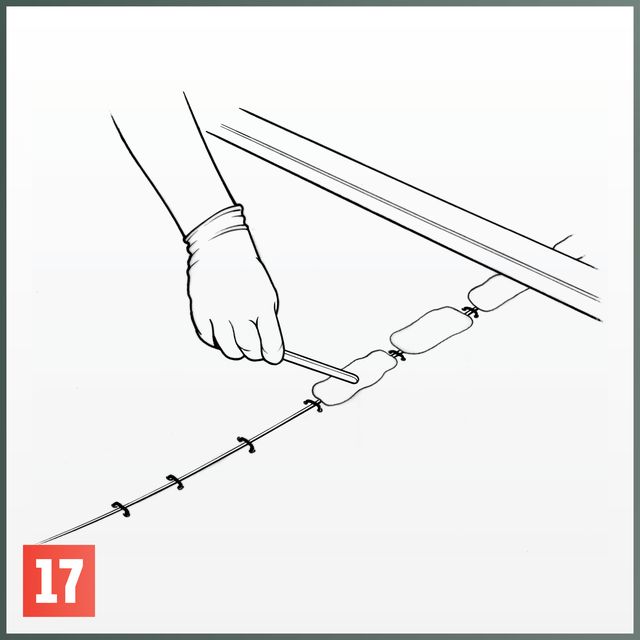
17 | Start epoxy tabbing, which is like tack welding, putting epoxy and fiberglass tabs between the wire sutures, on the interior of the hull.
18 | Once the tabs have cured solid, at least 24 hours but maybe more in humid climates, you can pull out all the wire stitches and lightly sand over the tabs to smooth things out.
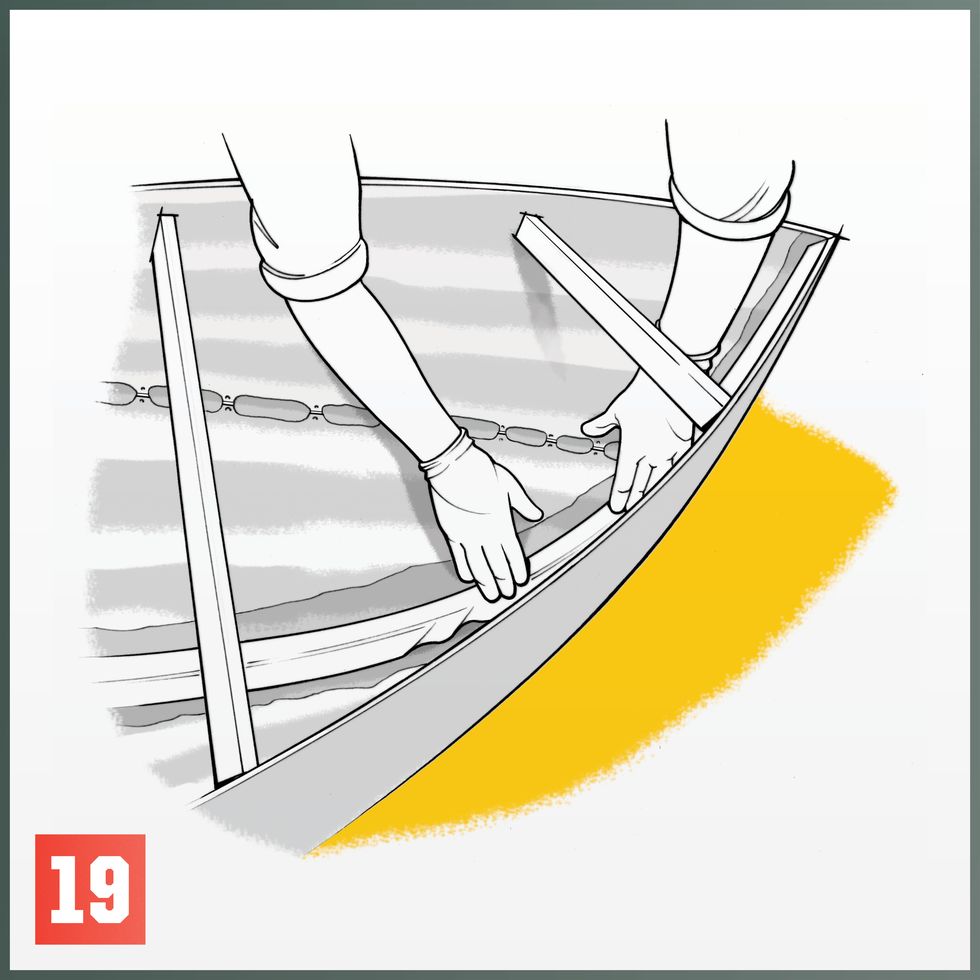
19 | Finish fiberglassing the interior seams of the boat. Set several layers of fiberglass tape in epoxy resin over the top. Then fiberglass the exterior plywood panel seams.
20 | Once the hull is to the designed thickness and all seams between the panels are taped with epoxy and fiberglass cloth layers, sheath the entire exterior of the boat with epoxy and fiberglass cloth. Some builders use a final layer of peel ply to control the resin-to-cloth ratio and eliminate air bubbles.
21 | Finish fiberglassing the seams of the interior of the boat, starting with narrow tapes up to the final width of the plans designated.
22 | Sand the boat inside and out to help smooth the edges and overlaps of the fiberglassing. Reseal with epoxy resin rolled and brushed over the hull as smoothly as possible.
23 | Sand and seal one final time and roll the boat over.
24 | Install the interior, such as seats, hardware, and the engine.
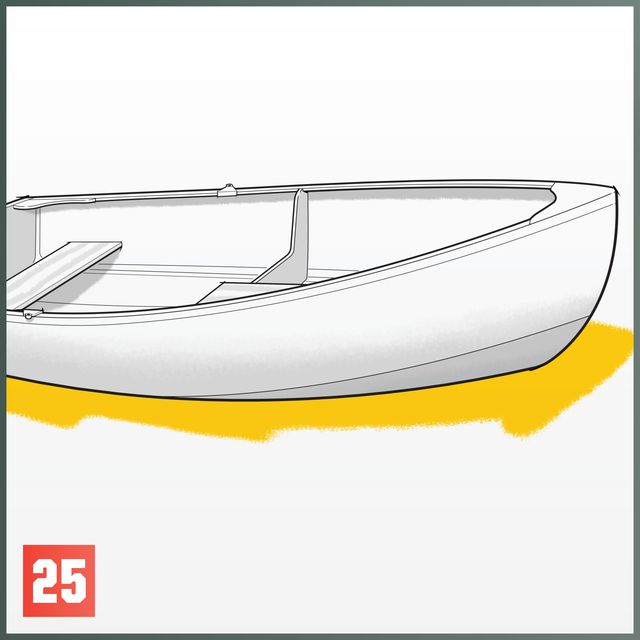
25 | Paint the entire boat, inside and out. Opaque paint offers the best UV protection, which is important to shield the boat from the sun’s reflection off the water.

.css-cuqpxl:before{padding-right:0.3125rem;content:'//';display:inline;} Pop Mech Pro .css-xtujxj:before{padding-left:0.3125rem;content:'//';display:inline;}
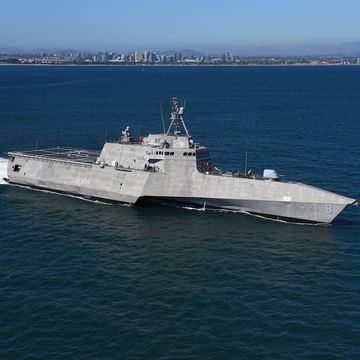
The Army Is Clearing Out for Coyote Drone Hunters

Can America’s Aging F-16 Overpower Russia’s Su-35?

Could the Chair You Sit on Have a Soul?

The F-35’s Development Road Is Mercifully Over

This Long-Range Howitzer Has Met Its Achilles Heel

Here’s How We Could Live in Trees

Inside the Development of America's New Nuke

Cooking Pizza in Breeo’s Live-Fire Oven
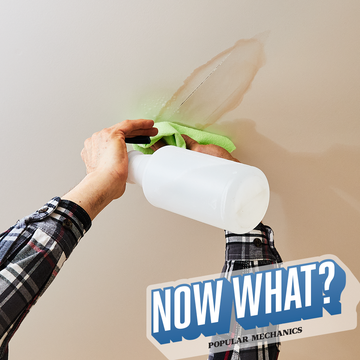
Ceiling Stains. Now What?

The Engine Driving Our Oceans Could Die by 2100

How Bessie Coleman's Sky-High Ambition Killed Her

Your shopping cart is empty!
Sailboat Plans 30-40ft

Bruce Roberts sailboat designs
Boat plans 30 - 40 ft .
This section of Bruce Roberts sailboat designs and boat plans cover the following vessels in the range of 30 to 40 foot. The Roberts, Classic, Henry Morgan, Offshore, Power Cat, PCF 36/40, and Canoe Stern designs. Boat building plans using steel, aluminium, fiberglass wood/epoxy, dependant on the design, are available. Information and prices are on each individual design page.
Study Plan Packages contain all the sheets #1 from the actual plans. Sail Plans and the various accommodation layouts pertaining to the design are shown on these sheets. There may be anywhere from two to eight #1 sheets which are all to scale and which measure between one meter and two and a half meters long each. They are intended as a more in-depth overview of the design in which you are interested.
Material Lists for the basic materials required to build the hull, deck and superstructure are included in the study plan package to help you with your budgeting. Where Fibreglass is mentioned as a material this means Balsa sandwich / Foam sandwich, Single skin or C-Flex. Most steel plans can be adapted to aluminium construction. Both moulded ply and strip plank can be used in conjunction with the wood epoxy saturation method. Sail and rig details are also shown on the study plan sets.
As the Study Plan Packages include the basic measurements in scale for the accommodation layouts, you can customize the layouts to suit your needs if what is presented is not exactly to your liking.
The link to download the Study Plan Packages is emailed to your email address and generally within 24 hours, The link to the Full Plan Sets is also generally emailed within 24. All study plans and full plan sets are downloadable in .pdf format for you to have printed at a nearby print shop. The study and full plan sets are available on CD's on request with postage cost depends on country.
To View drawings , photos, information and prices of the design that interests you just click on that design.
Payments: We only accept payments through PayPal. This method of payment protects both of us. Please be aware that there is no obligation or need to be a member of PayPal to use them to pay us using the normal various methods of payment.

Pram Dinghy Boat Plan
Roberts Pram Dinghy This Pram dinghy can be built in fiberglass or plywood. The pictures sho..

Classic 31 Boat Plan
Roberts Classic 31 This is an earlier design that some traditionalists may find appealing. It may..
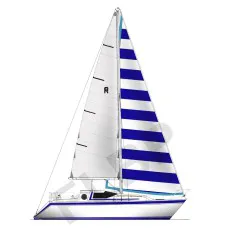
Roberts 310 Boat Plan
Roberts 310 This design may be built with either a regular trunk cabin or a pilot house. It is al..
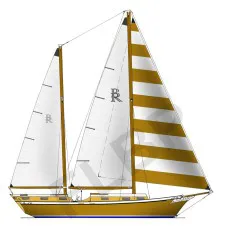
Henry Morgan 32 Boat Plan
Roberts Henry Morgan 32 This is an earlier design that traditionalists may find appealing. It is ..

Roberts 34 Boat Plan
Roberts 34 This is an earlier design that still enjoys a great amount of popularity. It has been ..
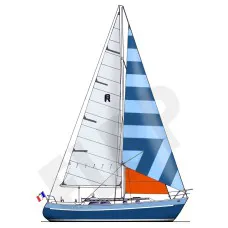
Canoe Stern 341 Boat Plan
Roberts Canoe Stern 341 Designed by Graham Shannon this is for those of you that are looking for ..
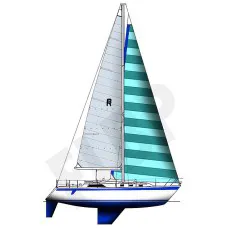
Roberts 345 Boat Plan
Roberts 345 Originally this was designed for lightweight frameless multi-chine steel construction..
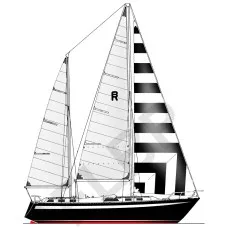
Roberts 35 Boat Plan
Roberts 35 This is a classic modern design that has been built as a production boat in many parts..
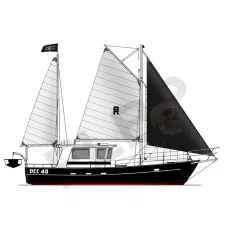
PCF 36-40 (Pacific Coast Fisherman) Boat Plan
Roberts PCF 36-40 (Pacific Coast Fisherman) This design may be built as a motor sailer for family..
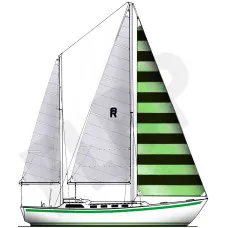
Roberts 36 Boat Plan
Roberts 36 This design is a well proven world cruiser as many are currently sailing in different ..
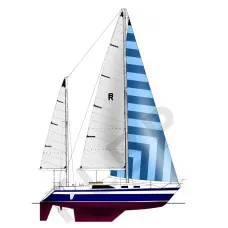
Roberts 370 Boat Plan
Roberts 370 Such has been the response to this design that plans for it's construction are availa..
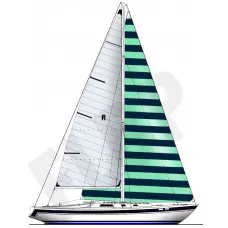
Offshore 38 Boat Plan
Roberts Offshore 38 Full plans for this design are available for building in round bilge Fibergla..
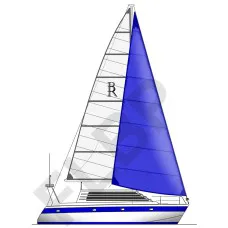
Power Catamaran 39 Boat Plan
Roberts Power Catamaran 39 These catamarans were designed to be built using the fibreglass panel ..

Roberts 39 Boat Plan
Roberts 39 This design is available only in multi-chine hull form, sloop or, with the addition of..
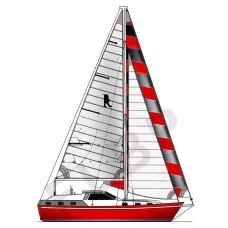
Roberts 392 Boat Plan
Roberts 392 This design is a companion to the Roberts 39 which until now had only been available ..

Roberts 40 Boat Plan
Roberts 40 This design comes with either a centre cockpit or a pilot house layout. There is adequ..
BoatNews.com
Free model boat plans: the MiniX, an easy-to-build radio-controlled sailboat
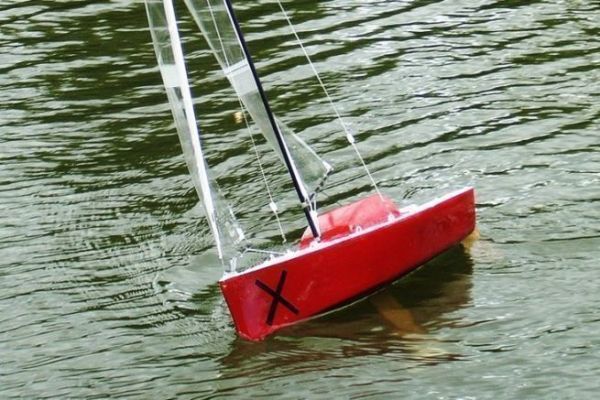
We set ourselves a challenge: to make a sailing model. In the end, after hours of reflection and work, we discovered that we took as much pleasure in designing and building as we did sailing our yachts. Here is the description of our project and the plans to download. Another article follows with the steps of the realization.
An easy-to-build, eye-catching, high-performance sailboat
Who hasn't dreamed of a little wooden sailboat with a beautiful canvas cover? The idea for this project is a child's dream.
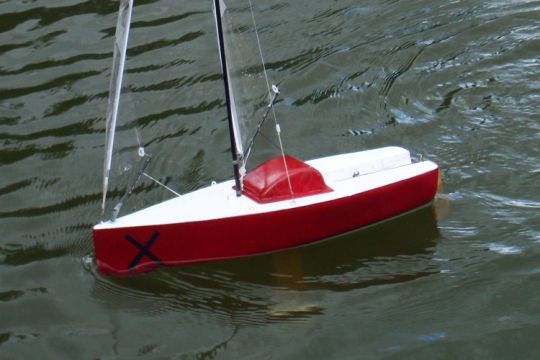
Sailing on a regular basis in "scale 1", we had the idea of having fun by sailing two boats to race in our "spare time". The boats had to meet the following specifications:
- Easy to transport . Measuring just 50 cm, our MiniX doesn't take up much space in a trunk. However, the keel and mast can be dismantled. If need be, the MiniX can even be included in our vacation luggage.
- Able to be thrown into the water "out the back of the car" without complicated implementation.
- No investment that would jeopardize our homes. As this is not a one-off activity, we didn't want to invest in expensive radio controls (our boat's biggest expense). A basic radio control kit is powerful enough to handle "small" sail surfaces.
- Resembling a sailboat at best, hence the presence of the deckhouse and cockpit. These two elements give a sense of scale without resorting to model-building. Above all, a sailboat must be beautiful. Don't we also sail for the pleasure of our eyes?
Modern construction
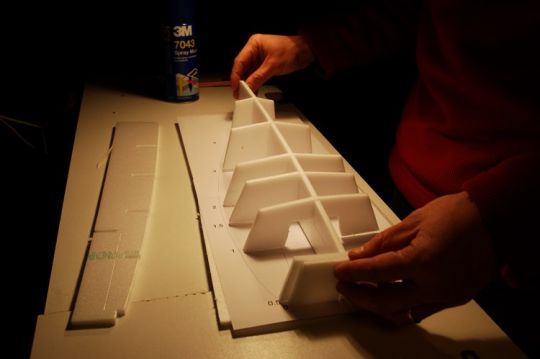
To keep it light (ready to sail , the MiniX weighs just 800 g), the hull is an extruded polystyrene/epoxy resin sandwich (laminated Depron). While this process is not impact-resistant (though...), the structure and sandwich make it very rigid. Together with the deck, the whole thing forms a kind of egg whose strength is astonishing. It's impossible to apply the slightest twist to the hull, despite its lightness (the bare hull weighs just 260 g).
Our yacht has a chine hull. But this doesn't detract from the look, as the chines are largely rounded and, combined with the straight bow, give the illusion of a beautifully shaped hull. When sailing close-hauled, the stern of the MiniX lifts off, limiting drag in the water.
Technical data
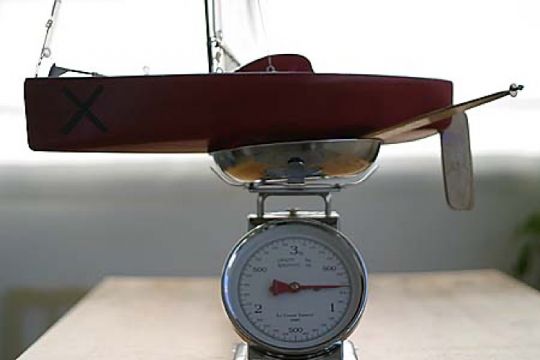
- Overall length (with rudder): 56 cm
- Hull length: 51 cm
- Width: 17.6 cm
- Draft: 25 cm (but this may change...)
- Air draft: 92 cm (mast: 86 cm)
- Operating weight (with sails, servos, batteries and keel ): 800 g
- Bare hull weight (without servos and keel ): 260 g
- Weight of ballast: 240 g (but may vary according to draught...)
- Wing surfaces: Jib= 6 dm² GV= 15 dm²
MiniX drawings
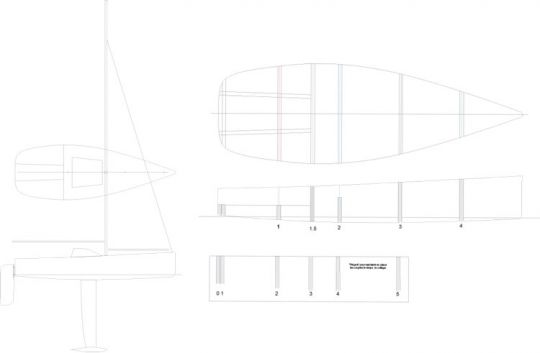
You can download the plans. They're simple and precise. We made our two boats by printing them on a basic A4 printer. Then we simply assembled the sheets by superimposing them and gluing them (repositionable spray glue ) to Depron. A sharp cutter is all it takes to build the MiniX with precision.
Just one thing: we've put a lot of heart and soul into building this yacht. We'd be delighted if our experience could be put to good use. Don't hesitate, help yourself! But be so kind as to let us know with a little comment. We'd love to hear from you.
Here you can download the first part of the plan in A4 PDF format .
With this you already have the complete boat. Based on the construction photos, there's not much missing to build the whole MiniX. But since we're taking care of you, here are the sail plans too:
- Mainsail plan
Real sails with webs for their shape.
The construction budget
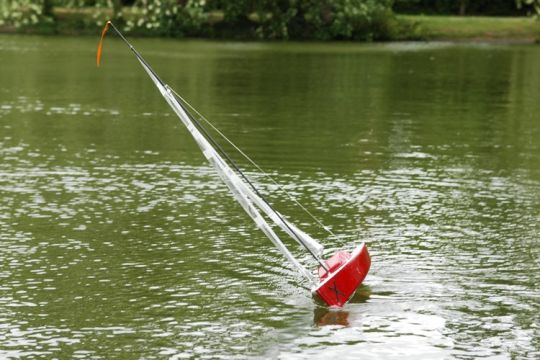
MiniX doesn't have to be expensive. We've always tried to find a way of "diverting" objects to make our project a reality. So it's hard to come up with an exact budget. It will be higher for someone who doesn't even own the basic tools , and much lower for someone who does it in the back of his already well-stocked workshop.
- 6 mm Depron sheet (2 sheets, 125 x 60 cm)
- Epoxy resin + fillers
- Glass fabric
- 4 mm plywood (a small piece for the keel , keel shaft and rudder)
- Carbon tubes (6 mm for the mast and 4 mm for the booms)
- GV carbon batten (1/10 mm in kite stores)
- Remote control servos kit ( first price: ?60)
- Florist paper for the sails (a good opportunity to give pleasure...)
- Blenderm (surgical tape), available from chemists, to join the sails. Cut the 20 mm roll in half to double its length.
In the end, we estimate a maximum budget of ?120 per boat (calculated in 2021).

Because a construction project like MiniX is above all a team project... And in a team it's good to be complementary.
The MiniX project went through a long phase of gestation - reflection - intellectualization - drawings - exchanges - helping hands to get to this stage. Today, it's sailing thanks to this pooling of skills. We hope you'll enjoy this project as much as we have. And we look forward to hearing from you in the comments or on the forum. Enjoy!
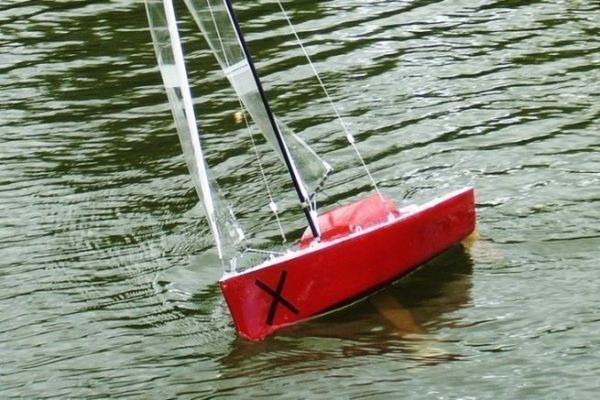
Sailboats embody the mystery of the sea, of going only where the wind is willing to take you. We offer a variety of sailboat sizes, using several construction techniques. We offer sails, hardware and rigging for many of our sailboat designs. This enables you to focus on building your boat, not searching around for all the bits and pieces needed to complete the project.
Free online book:
- Rigging Small Sailboats
- Sailboat Hardware Notes

Glen-L 25 - Plywood

Building a boat might sound like a big project – and depending on the kind of boat you want, it can be. However, with the right plan, it’s far from impossible, offering you the prospect of owning a boat without spending huge amounts of money on it.
For anyone who thinks that sounds like a fun challenge, we’ve had a look online to see what other people have been trying – and as a result, here are our favorite 27 DIY boat plans you might like to have a go at copying at home.
Table of Contents
1. How to Build a Boat – Popularmechanics.com
2. how to build a sneak boat – kara hummer plans, 3. know how: build your own boat – sail magazine, 4. build a 7.5ft boat with 2 sheets of plywood, 5. build your own 12′ x 4′ simple aluminum boat – boat design net, 6. diy foldable boat for only 30$ fits in car backseat, 7. build a wooden boat – mother earth news, 8. portable boat plans, 9. weekender sailboat build, 10. swamp boats, 11. welcome to my dreamboat project, 12. homemade pontoon boat: 8 steps (with pictures) – instructables, 13. $100 homemade kayak, 14. how to build a recumbent pontoon pedal boat – mother earth news, 15. how to make boat using pvc pipe and 42cc 2-stroke engine, 16. pontoon boat picnic table: 8 steps (with pictures) – instructables, 17. wooden boat building step 1: lofting boat plans, 18. homebuilt pontoon boat/double-hull kayak, 19. homemade cooler fishing boat with foldable pontoons, 21. diy boat plan: a rowboat can support a trolling motor, 22. building a wooden boat: 12 steps (with pictures) – instructables, 23. one sheet sampan, 24. building a cheap sail catamaran, 25. couple builds wooden yacht in backyard – 5-year amazing time lapse, 26. plywood lath coracle, 27. diy simple wooden toy boat: woodworking for kids, lots of great plans for all kinds of boats.
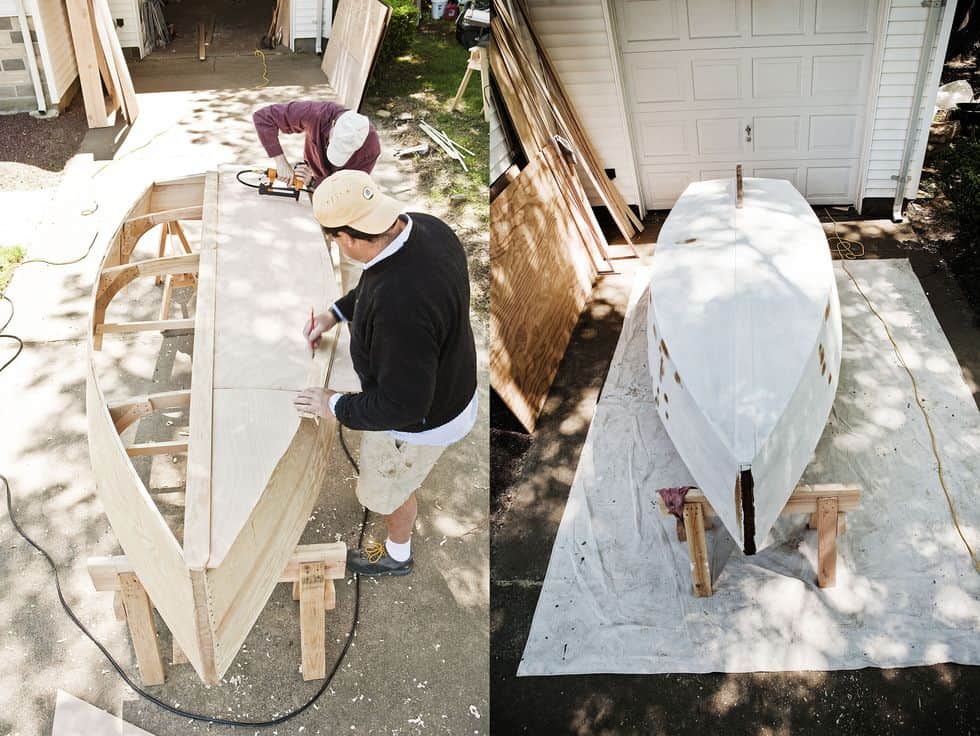
If you’re toying with the idea of building your own boat , this post will be a fascinating read. In it, this DIYer explains how he dusted off some decades-old plans for building a boat to try his hand at his ancestral trade. It takes you through the process in great detail, giving you plenty of info about each step, so once you’ve finished reading, you’ll have a much better idea about whether this is a project you want to tackle.
Check More Details
For anyone who enjoys duck hunting and who wants to try building their own sneak boat, this is a video for you. In it, this YouTuber explains how he tackled a similar project, giving you all the tips and advice you’ll need to make a success of your project when it’s your turn to try.
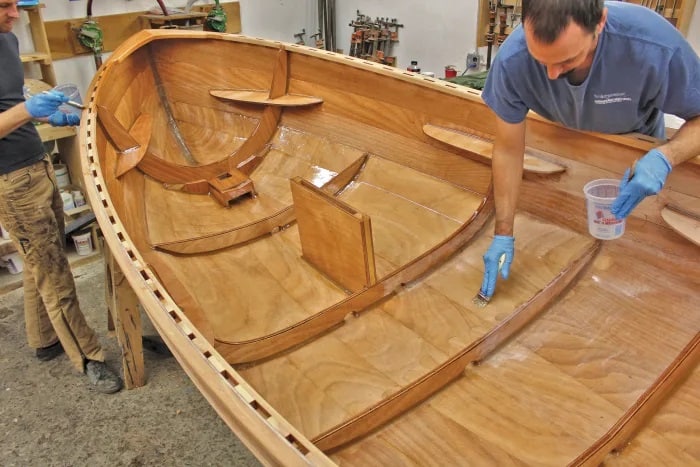
This post is not exactly a plan as such, but it’s full of the kind of useful information that any first-time boatbuilder should know. The writer starts off by listing all the reasons why you really shouldn’t build your own boat – and if after reading that, you’re still determined to go ahead with it, his experience and advice will help make sure you make the best job of it.
Depending on what you hope to achieve – as well as your previous DIY and boat-building experience – your chances of success when trying to build your own boat can vary enormously. However, if what you hope to make is a modest boat of the kind you can take into a lake for a day of fishing, that’s the kind of thing most people can hope to achieve. And if that sounds like you, this video tutorial will show you how to make a serviceable 7.5ft craft from two sheets of plywood.
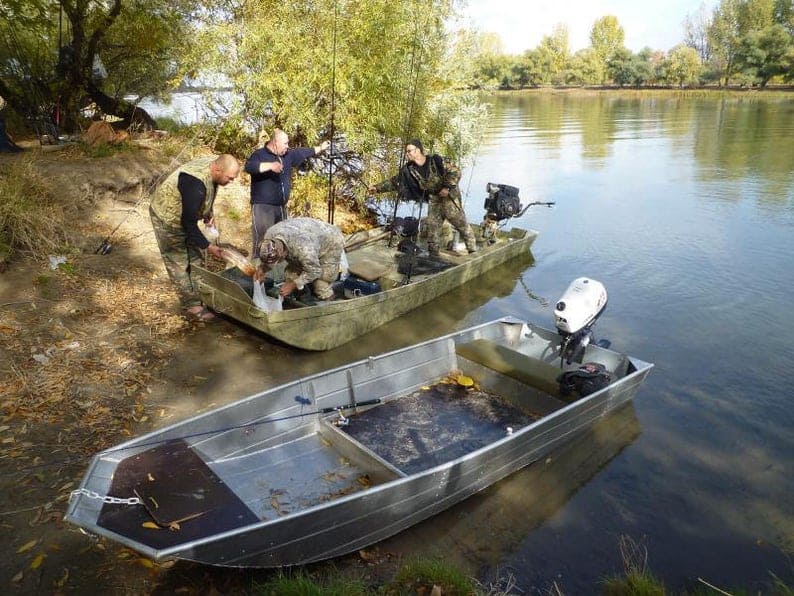
The aluminum boat this post teaches you to make is suitable for rowing or being propelled by a small motor . It’s ideal for sheltered inland waterways for activities like fishing, and if that sounds like the kind of thing you want to make, this post includes pdf plans that tell you exactly how to do it.
Making a DIY boat doesn’t need to cost a fortune, and if you’re on a limited budget, this is the plan for you. In it, you’ll learn how to make a small foldable boat that you’ll be able to fit in the back seat of your car – without spending more than about $30. Sound like something you’d like to try? Then give the video a watch!
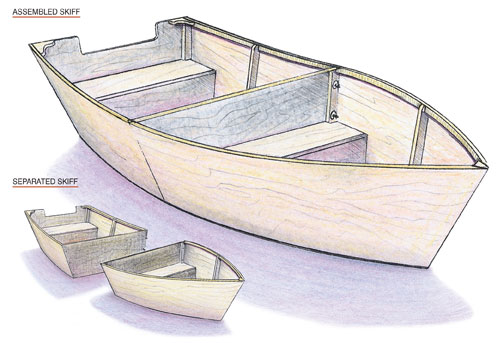
In this post, you’ll find detailed instructions for making a simple yet elegant wooden boat that would be perfect for fishing trips out onto a lake or many other similar activities. We like the way this plan includes a simple step-by-step guide along with plenty of diagrams to show you exactly what you need to do, allowing you to make something just like it at home.
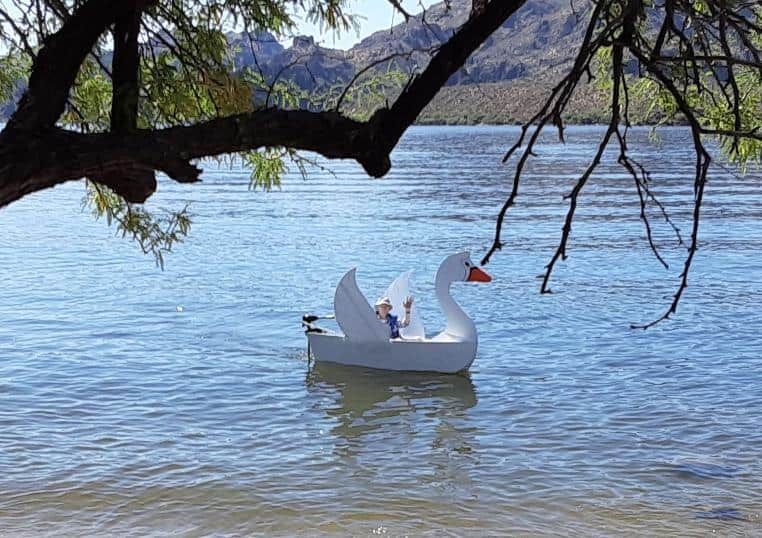
This is a great resource for anyone who is thinking of building themselves a simple pleasure craft since it contains not just one but several relatively easy boat-building plans. You can browse the plan and choose from a swan boat, a sheet ply skiff, a composite cruiser and several others. And then when you know which one you want to build, this site has all the details you’ll need to make a success of it.
For those looking for a more ambitious project, this video should be worth a look. In it, you get to see the development as this YouTuber’s sailboat took shape between September 2001 and summer 2002. It’s not exactly the kind of plan you’ll be able to follow exactly, but his impressive work should be a source of inspiration. Then it’s just down to you to find out how to build something similar yourself.
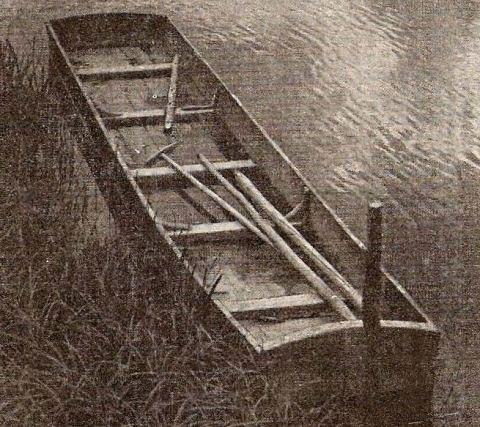
As you can see from the photos in this post, boats like this have been around for many years – and boats like this are found around the world anywhere that shallow waters or swamps exist. They’re simple to make too, and this plan gives you all the info you need to make one, including sourcing the wood from growing trees and putting the whole thing together. A fun project and one we’re sure plenty of people will enjoy attempting.
If you’re looking for a long watch – and a possible source of inspiration – this video is the first part of a multi-episode series about how this YouTuber went about building his dream boat . For those who are interested, it’s sure to give you some ideas about what’s possible – as well as plenty of ideas for how to tackle it.
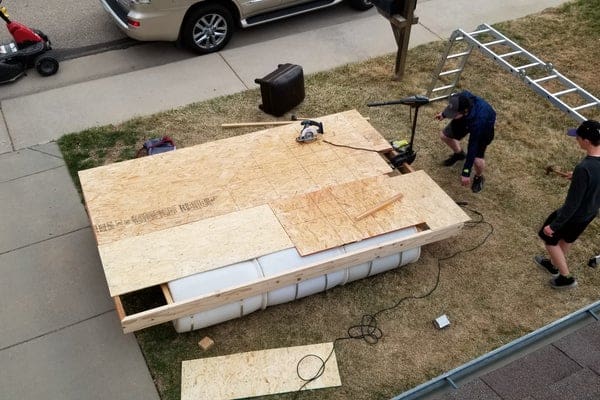
We love the way the boat in this tutorial looks. It’s so basic and unpretentious, but it also looks like a whole lot of fun. Want to know how to make one yourself? Then check out this post for more details.
Buying a ready-made kayak can set you back a whole lot of money, but with a few basic DIY skills and a little bit of determination, you can build one yourself for much less. This video teaches you how to make one for only $100, offering a saving that sounds too good to refuse.
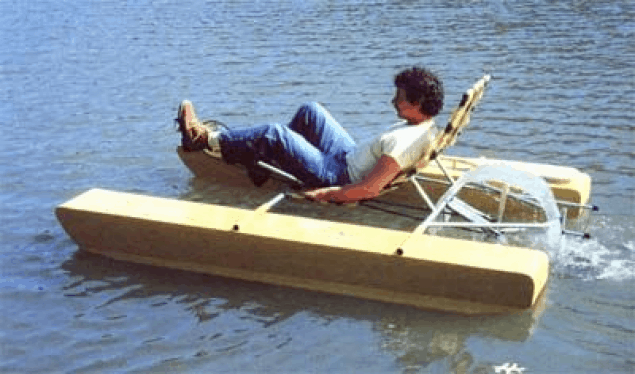
If you’ve ever wanted to own your own pedal boat , this is the plan for you because it teaches you how to build one yourself! It discusses important issues like flotation and gives you all the information you need to complete the project. And if you think you’d like to have a go, why not see if you can build something similar?
Here’s an original idea we loved! In this video, this YouTuber shows us how he built a functioning boat – out of PVC pipe! It’s certainly unconventional, but it looks like it works perfectly. So if anyone is looking for a fun and off-the-wall to try project, this could be just the thing!
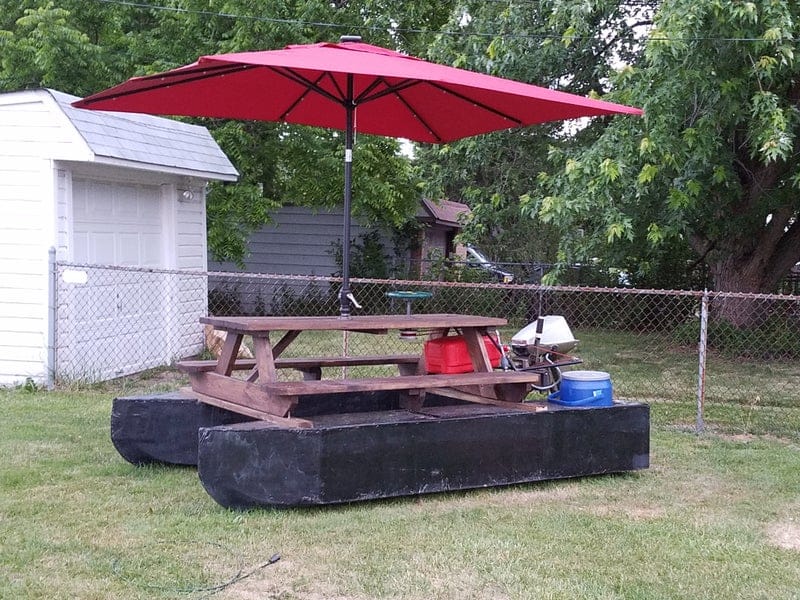
The boat in this plan is one of our favorites because, while technically it’s a DIY pontoon boat , in practice, it’s more like a floating picnic table. With a boat like this, you can power out to the middle of the lake before cutting the engine and enjoying a nice lunch in perfect tranquility. This is something we’re thinking of trying ourselves!
This video is the first instalment in a series of tutorials detailing how this YouTuber built a boat from scratch. This part deals with the start of the project and lofting the boat plans , but if you like the way he works, you can also check out the other videos he’s uploaded and see how the final thing turns out.
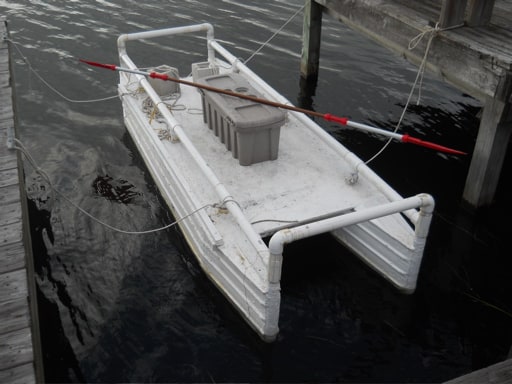
For anyone who wants to make a functional boat without spending a fortune, this plan is perfect. The boat it teaches you to make is very “DIY” since it’s made of nothing more than PVC piping and some other similarly inexpensive materials. However, it looks like it floats, so if that’s all you need – and you aren’t too worried about looking flash – this is a plan that could be fun to copy.
If you like fishing and you’re looking for ideas for an individual fishing boat, you’re going to love this video. In it, we get to see this YouTuber’s eccentric creation that, to us, looks a bit like a floating armchair perched on top of three coolers. But that sounds like all you need for a great fishing trip, right? And we’re sure lots of people will enjoy trying to make something similar.

The sub-heading to this plan is “as simple as it can get”, and that’s a pretty accurate way of describing this boat, both in terms of design and construction. The details state it has a displacement of 230lbs, so it can comfortably accommodate one person, allowing you to get out on the water without spending much money at all.
This short tutorial gives you a simple suggestion for building a motorboat that is both easy and inexpensive to make. In the video, you can see that the boat struggles a little with two people in it, but it still works. This could be a great project to attempt for anyone who wants to have a go at building their first boat, and if that includes you, it’s recommended watching.
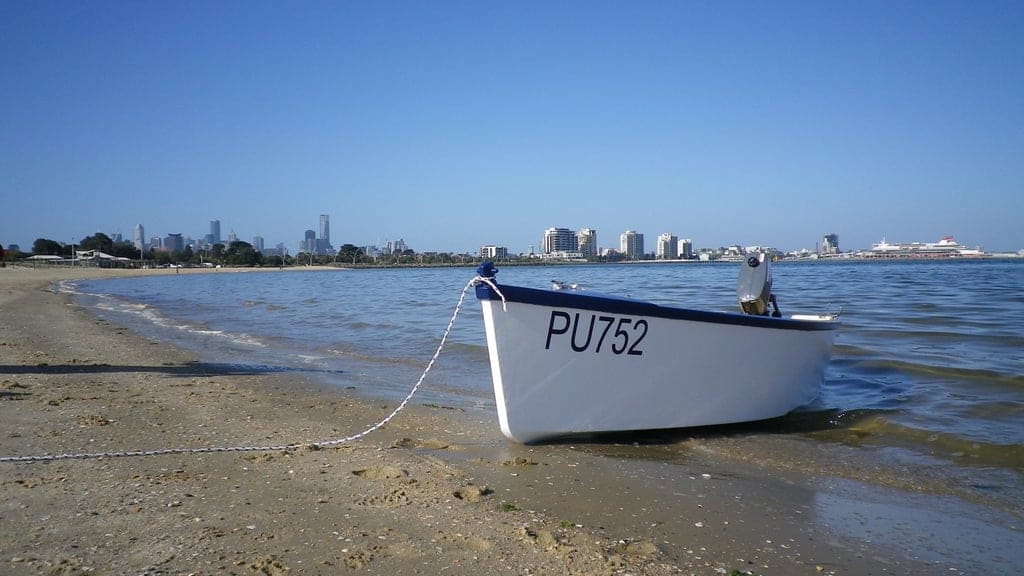
This is the third plan we’ve included from the Instructables website, but this is by far the most professional of the three. The boat this tutorial teaches you to build looks as though it could have been made by a professional. The plan is easy to follow though, so if this is the kind of boat you want , this is a post that should be well worth a look.
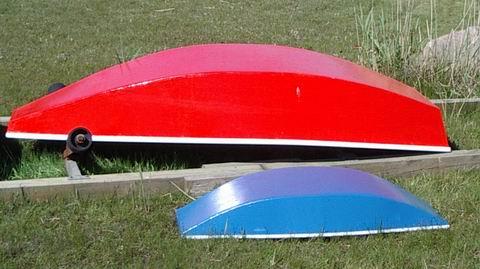
As this post explains, a sampan is a type of boat from Southeast Asia, and the word “sampan” comes from the Chinese meaning “three planks”. They are a popular boat in the region because they are easy to construct and extremely reliable, and if you’d like to try building one yourself, this plan will teach you how to do it.
This is a plan for anyone who’s up for a challenge because in it, you’ll learn how to make a DIY sail catamaran. The video is only about five minutes long, but as long you have some reasonable DIY skills and a bit of common sense, it shouldn’t be too hard to replicate, so why not see if you’re up to the task?
While not many people will have the time, skills or determination to finish a project like the one in this video, we still thought it merits a place on our list because of how impressive what they did is. Over five years, this couple built their own boat from scratch, and this video documents their progress. Check it out – it will blow your mind!
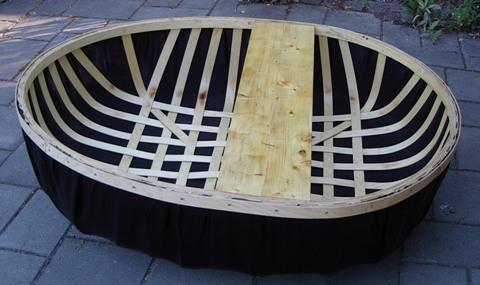
Among the very first boats ever invented, the coracle is a simple design that’s easy to make and fun to play about in. And if you think you might like to have a go, this is the plan that will teach you how to do it!
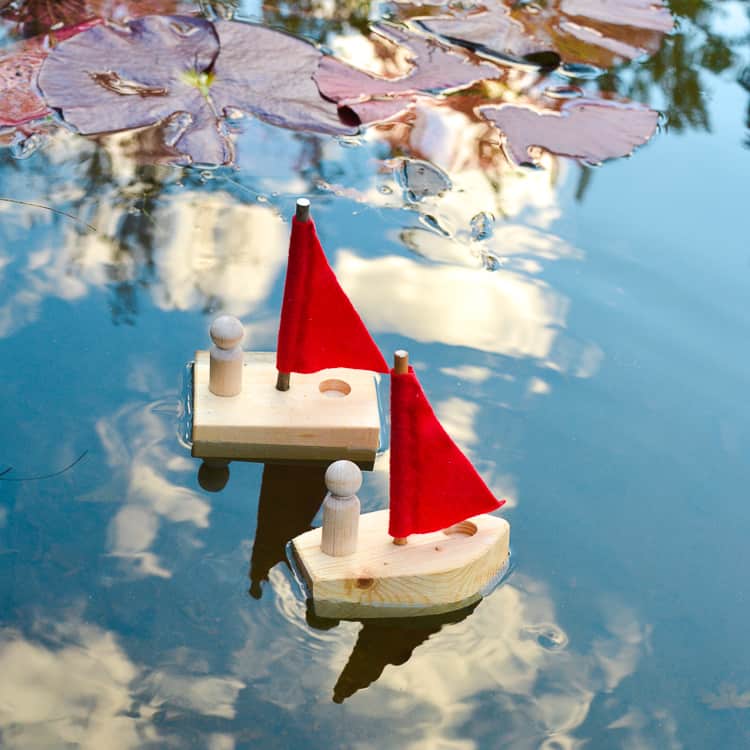
Perhaps building a real full-sized boat might be a bit much for you – but if you have kids, maybe making a miniature toy one with them could still be fun. It could also be a way to fire their creativity and imagination, and who knows? When they grow up, maybe they’ll build a real one for you in return!
As you can see, whatever kind of boat you hope to build, there are all kinds of plans that will show you how to do it.
We’ve enjoyed collecting these plans for you, so we hope you’ve enjoyed reading and watching them too. And above all, we hope we’ve helped you find the plan you were looking for to build a DIY boat of your own.
Related posts:
- 27 Homemade Pontoon Boat Plans You Can DIY Easily
- 16 Homemade Boat Blinds Plans You Can DIY Easily
- 17 Homemade Boat Seats Plans You Can DIY Easily
- 18 Homemade Boat Upholstery Plans You Can DIY Easily
3 thoughts on “27 Homemade Boat Plans You Can DIY Easily”
What makes a boat stable in the water is it the keel
i want to make a model for a school project out of tinfoil and hot glue it together and were going to put pennies in and see if it floats is there too much wait?
i meant to say weight not wait
Leave a Comment Cancel reply
Save my name, email, and website in this browser for the next time I comment.

The 5 Best Sailboats For Beginners

Last Updated by
Daniel Wade
December 27, 2023
Sailing is a fun activity for people of all experience levels. In fact, learning to sail a basic boat is relatively easy—in the right environment, you can start cruising with minimal experience.
However, the idea of a beginner commanding a 55-foot ketch in the middle of the Atlantic Ocean is a bit ridiculous. Even though virtually everyone can sail, beginners should learn the basics in a controlled environment—and on the correct boat.
Boat size doesn’t necessarily affect its beginner-friendliness, because sailors need to take into account factors such as rig simplicity and handling characteristics.
Many beginners make the mistake of picking the wrong boat to begin with, which can lead to frustration and turn them off of sailing forever.
To mitigate these issues, this article will cover the best sailboats for beginners —so you can get on the water and start sailing safely and comfortably.
Table of contents
Best Rigs for Beginners
There are many types of sailboat rigging , and some are more beginner-friendly than others. Unfortunately, some of the most aesthetically pleasing rigs are also the most complicated.
Eventually, sailors can acquire enough skill to master complex rigs, but it’s best to start simple.
Arguably, one of the simplest sailing rigs is the Lateen Rig. This rig consists of a mast, boom, and spar, along with a single halyard and mainsheet. With only two ropes in its simplest configuration, the Lateen Rig makes an excellent starter sailboat, and it will be featured on this list.
For larger boats, the Bermuda Sloop rig is an excellent choice. This rig is quite common and includes a jib for a larger sail plan.
For those who desire a slightly more robust (but single sail) layout, the gaff-rigged catboat is also an excellent choice. This versatile craft (and rig) has a large and relatively simple single sail, which is easier to handle than multiple sails.
Top Five Sailboats for Beginners
Now, we’ll go over the top five sailboats for beginners . These boats will descend in order from smallest to largest, but not by the level of experience needed.
Remember, just because you’re new to sailing doesn’t mean you have to settle for a boat that’s too small. Beginners can handle larger boats with some training, and some are easier to handle than their smaller counterparts.
The following boats were chosen because of their handling characteristics, low cost-of-ownership, and simplicity, as all of these factors are important for choosing the best beginner sailboat.
5) Sailing Dinghy
The sailing dinghy is the quintessential starter sailboat. These tiny, lightweight, popular, and highly affordable little craft is easy to operate and relatively difficult to capsize. The popular Optimist Sailing Dinghy, while designed for children up to the age of about 15, can be used (sometimes hilariously) by adults as well. An Optimist-style dingy is a great option for beginners over the age of 15, as boats of this style can be found in a variety of sizes. The sailing dinghy is a very popular youth racing sailboat, especially in the United States and the United Kingdom. While it’s not particularly fast, this little boat has wonderful handling characteristics and is relatively difficult to capsize. This open-cockpit boat uses a centerboard and detachable tiller and can be beached or carried atop a car without much hassle. The mast is removable, and all parts are easily stowed. Overall, the Optimist and its copycats are a remarkable little craft, equally useful as a tender for a larger boat or a standalone beginner sailboat.
Dinghy rigs vary between builders, but many use the simple Spirit Rig. The rig consists of a single sail and mainsheet, along with one mast, boom, and spar. The leech is stiffened by battens, and ties along the luff secure it all to the mast. Hoisting and securing the rig is easy, and lines are secured to the boat by a cleat. This simple rig has plenty of sail area for most places, and sailors can secure the mainsheet to a block or simply hold it in their hands.
The price of sailing dinghies can vary widely depending on multiple factors. Professionally-made sailing dinghies start around $3,500 new, and plywood kits are available for around $1,000 to $2,000. Used dinghies (including Optimist sailing dinghies) can be found on Craigslist for as low as a few hundred dollars.
{{boat-info="/boats/vanguard-sunfish"}}
The Sunfish is a brilliant little sailboat, and a very fast boat indeed. This little racing dinghy, while only 13 feet in length, can be an enormous amount of fun for beginners and experienced sailors alike. The best way to describe the handling of a Sunfish is, ‘tender,’ though it’s not difficult to master this little boat. For its size, the Sunfish has a relatively large sail area and a very shallow draft. This boat has a small cockpit and can be controlled easily by a single person. The large sail plan of the Lateen-Rigged Sunfish makes for excellent performance in light winds and amazing speed on windy days. The Sunfish is a lightweight fiberglass boat with a simple rig and is a great step-up from a sailing dinghy. It’s possible to learn how to sail on this boat, but every sailor who’s spent time on a Sunfish will probably recommend bringing a towel. The boat is relatively easy to capsize for beginners and it heels aggressively, but these characteristics can teach sailors some important lessons. The heeling characteristics of the Sunfish can help beginners get accustomed to the feeling and help them understand the limits of a sailboat and how to avoid capsizing.
The Sunfish features a Lateen Rig, which has some shared characteristics with the simple Spirit Rig. The Lateen Rig has a single spar, mast, and boom, and is easy to set up and dismantle. The mast is removable as well, making stowing and transportation relatively easy. The large sail plan of the Sunfish makes it ideal for lakes and other areas where the wind is sporadic or very low, and the boat can be safely handled in many conditions. The boat is great for racing and learning and is also available in a Bermuda rig. The Sunfish is recognizable by the distinctive fish logo in the top corner of the sail, and the classic rainbow sails striping.
The Sunfish is still commercially manufactured. You can purchase one new from the factory for around $5,000 today, and options are available to make the boat your own. While the boat is designed to be sailed by a single person, two adults can purchase this boat and use it together comfortably. Used Sunfish prices vary, but a fully-outfitted boat in good condition can cost upwards of $1,000. They hold their value well, and they’re a great choice for beginners.
{{boat-info="/boats/vanguard-laser"}}
The Laser is considered by many to be the Sunfish’s main competitor. The two boats are the same length (13 feet 9 inches) and share many of the same handling characteristics. However, the boats do have some notable differences. Many people consider the Laser to be a step-up from the Sunfish in difficulty, as the boat handles much more like a racer. The Laser has been used in the Olympics for racing. The laser is small and simple enough for beginners but requires skill to operate. Beginners can learn a lot from sailing a Laser and have an enormous amount of fun in the process. This fast little boat is simple and easy to set up but handles like a racecar. If you’re a beginner on a laser, you’ll probably capsize at some point—which isn’t always a problem if you’re in a controlled environment, as the boat can be righted easily.
The laser is a Cat Rigged boat. This means it has only one mainsail and no headsails. The simple rig has a mast and a boom and is very easy to set up. The sail area of the laser is relatively large and designed for speed in high winds. The rig combined with the overall design of the sailboat makes it handle tenderly, which may be off-putting to some beginners. Regardless, it’s still a blast to sail for beginners with some experience.
New Laser sailboats start around $6,000 which is slightly more than the Sunfish. This simple centerboard cruiser is constructed as a race boat, which can explain some of the price increase. Used Laser sailboats are available on the market, though usually not as common as the Sunfish. Used Laser prices vary widely.
2) Gaff-Rigged Catboat
The gaff-rigged catboat isn’t a brand of boat—it’s a style of a sailboat that was once a popular workboat on the New England coast. This boat, which has only one mainsail and no headsails, is available in a wide range of designs. Catboats are famous for their handling and power and make a great sailboat for beginners. These vessels are available with centerboards, keels, cabins, and in open designs. Most catboats range from 15 to 19-feet long and can be built from wood or fiberglass. Catboats are easy to handle, and one who learns on a small catboat can easily transition to a larger one. Besides being one of the most easily recognizable sailboats, catboats are also some of the most versatile. A catboat can be just as suitable for lake cruising as it is for coastal waters.
The most common type of catboat rig is the Gaff Rig. This classic and robust rig is more complex than the simple Spirit and Lateen rig, but it’s more suitable for a ‘proper ship.’ The Gaff Rig can provide similar power as an equivalent Bermuda Rig, with much more elegance and a shorter mast. Many sailors prefer the classic Gaff Rig for its handling characteristics and durability.
It’s impossible to specify the price of catboats because they vary so much in design and size. New catboats (between 15 and 25-feet) can be purchased for less than $20,000, and used boats are numerous and varied. Cabin catboats tend to cost more, especially new—some run for more than $50,000 with a high level of amenities, including a head and galley. Numerous catboat plans are available online, and sailors report constructing them (usually of plywood) for just a few thousand dollars.
1) West Wight Potter 19
{{boat-info="/boats/west-wight-potter-19"}}
The West Wight Potter 19 is a fiberglass sailboat designed for safety, easy handling, and beginner-friendliness. This 19-foot trailer-sailor features a cabin with a vee-berth, a simple rig, and a retractable keel. The West Wight Potter 19 could potentially be the best cabin sailboat for beginners, and certainly one of the safest—the West Wight Potter 19, according to the manufacturer, is quite literally unsinkable. The hull is filled with buoyant materials, allowing the boat to be flooded and remain afloat. However, unsinkability isn’t the only characteristic of this boat that makes it ideal for beginners. The rig is simple and easy to set up, and the handling characteristics are excellent. The boat is not prone to aggressive heeling and handles confidently in a variety of conditions. While one generally wouldn’t consider it to be a blue-water cruiser, it’s still extremely capable—one sailor even sailed this vessel from California to Hawaii , which is over 2,000 nautical miles. The theoretical hull speed of this boat is around 5.4 knots, but it actually has a tendency to plane and achieve higher speeds. It’s a flat-bottomed cruiser, making it easy to beach and transport with its retractable keel and removable rudder. The West Wight Potter 19 is a great introduction to large sailboats and carries amenities normally reserved for boats at least 1/3 larger.
The West Wight Potter 19 is a Bermuda-Rigged sloop. The sail plan is sufficiently large to propel the boat in a variety of conditions, but not so large that it overpowers the boat. Sailors can single-hand the boat with ease, and set up and takedown are easy and require no special tools. The boat handles well in a variety of conditions and is well-known for its superior stability. The rig comes apart easily and can be stowed and trailered by one person.
The West Wight Potter 19 has been produced and sold commercially since the 1970s, and the used market has plenty of boats available, generally starting around $5,000. New West Wight Potter 19 sailboats are remarkably affordable compared to other boats with comparable characteristics. The West Wight Potter 19 is manufactured by International Marine in California. New sailboats start at just shy of $25,000. Owners can add an enormous range of extra features to their boats, including a hull-strengthening ‘blue water’ package, a stove, a head, electrical power, spare parts, and much more. The boats are highly customizable and can be outfitted for weekender sailing or long-term liveaboard cruising.
How to Pick a Sailboat
Picking a sailboat for beginners doesn’t have to be difficult. Before deciding on a boat, consider your experience level and location.
If you only have access to rough ocean, it may not be the best idea to get an open dinghy.
If you live near a lake, a Sunfish could be a great way to start.
Also, consider your budget. If you’re looking for a $50 sailboat, you can probably find one, but it won’t be ideal.
If you have just a few thousand dollars to spend, you can set yourself up nicely with a little research .
Also, consider what you want to do with the sailboat. Recreation, fishing , cruising , and exploration are options, and require different kinds of boats.
Whichever you end up choosing, make sure you try it out and can sail it comfortably.
Related Articles
How To Buy A Beginner Sailboat
Sail Maintenance For Beginners
Can a Novice Sail Around the World?
I've personally had thousands of questions about sailing and sailboats over the years. As I learn and experience sailing, and the community, I share the answers that work and make sense to me, here on Life of Sailing.
by this author
Best Sailboats
Most Recent

What Does "Sailing By The Lee" Mean?
October 3, 2023


The Best Sailing Schools And Programs: Reviews & Ratings
September 26, 2023
Important Legal Info
Lifeofsailing.com is a participant in the Amazon Services LLC Associates Program, an affiliate advertising program designed to provide a means for sites to earn advertising fees by advertising and linking to Amazon. This site also participates in other affiliate programs and is compensated for referring traffic and business to these companies.
Similar Posts

Affordable Sailboats You Can Build at Home
September 13, 2023

Best Small Sailboats With Standing Headroom
December 28, 2023

Best Bluewater Sailboats Under $50K
Popular posts.

Best Liveaboard Catamaran Sailboats

Elizabeth O'Malley
June 15, 2022

4 Best Electric Outboard Motors

How Long Did It Take The Vikings To Sail To England?

10 Best Sailboat Brands (And Why)
December 20, 2023

7 Best Places To Liveaboard A Sailboat
Get the best sailing content.
Top Rated Posts
Lifeofsailing.com is a participant in the Amazon Services LLC Associates Program, an affiliate advertising program designed to provide a means for sites to earn advertising fees by advertising and linking to Amazon. This site also participates in other affiliate programs and is compensated for referring traffic and business to these companies. (866) 342-SAIL
© 2024 Life of Sailing Email: [email protected] Address: 11816 Inwood Rd #3024 Dallas, TX 75244 Disclaimer Privacy Policy

Free Boat Plans
The plans offered here are free public domain boat plans.
Cabin Cruisers
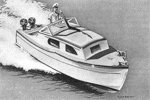
Canoes and Kayaks

Fishing and Utility
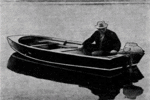
Speed Boats

Privacy Overview

- Basic Kayaking Knowledge , Learn
15 Free Boat Plans You Can Build This Week (with PDFs)
Boatbuilding is one of the most ancient forms of craftsmanship still alive today. As long as our ancestors have had a curiosity about exploring open waters, they have been practicing and honing their boatbuilding skills.
To be honest, however, building a boat is no small task. It will require a lot of work and patience to ultimately create a finished product that you are happy with and that is actually seaworthy.
Of course, we have also included a few free boat plans. You can keep in your back pocket for the next time you are asked to build a cardboard boat as part of a contest or lakefront teambuilding adventure.
We hope that these resources help you in your journey to build your own boat!
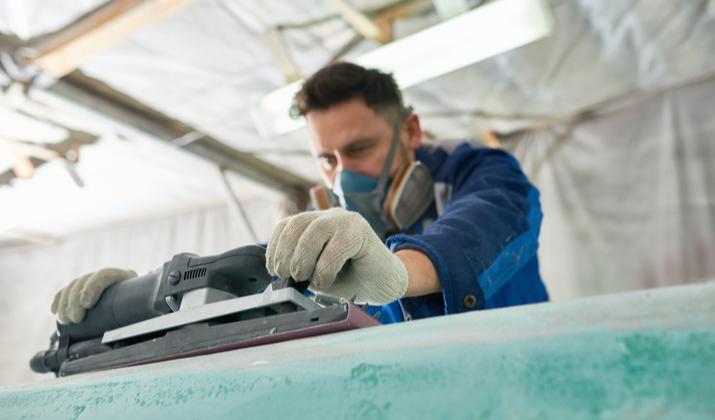
Photo by SeventyFour via Shutterstock
Free Boat Plans
Why build your own boat, 1. the wanigan, 2. the mouse, 3. the slipper, 4. the handy andy, 5. the junior, 6. the jolly roger, 7. the cork, 8. the hobby kat, 9. the tern, 10. the falcon, 11. the white duck, 12. the sea midge, 13. the zephyr, 14. the gypsy, 15. the crazy cardboard boat, 15 free boat plans you can build this week (with pdfs) – final thoughts, share on pinterest.
- The Wanigan
- The Slipper
The Handy Andy
- The Jolly Roger
- The Hobby Kat
The White Duck
- The Sea Midge
The Crazy Cardboard Boat
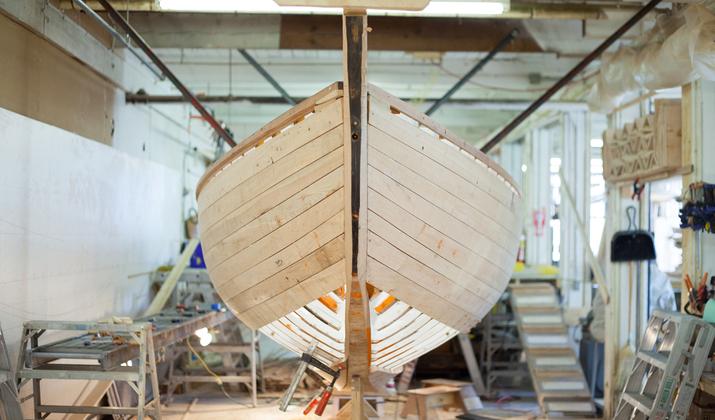
Photo by Halsey via Shutterstock
There are a lot of reasons why you should explore building your own boat versus buying a pre-made model. Here is a quick breakdown of the most obvious benefits:
- You will know the ins and outs of your finished boat better than anyone
- It can be a great project to work on with your teenage or even adult children
- You will gain valuable skills molding and shaping wood and other materials
- You can design your boat for your specific needs
- You don’t have to trust the sometimes-questionable manufacturing of mass-produced boats
- You can create a boat that functions as your second home on the water
- You can save money if you source materials mindfully
Of course, most first-time boatbuilders still experience some level of trial-and-error. With patience and perseverance, however, you can craft a one-of-a-kind vessel that has no equal anywhere in the world.
Free Boat Plans You Can Build This Week (with PDFs)
PC Duckworks Boat Builders Supply
The Wanigan boat began as a garvey design, which is one of the older boat plans known to the Americas. Traditionally, these boats were built as work scows and were very popular among American summer camps.
The design itself is very simple, but these boats can carry heavy loads. It can also handle a trolling motor being mounted to the stern so you can cover more ground if you want to use it as a fishing boat.
The creator of this boat plan became aware of some of the downsides of the garvey design, such as the heavier weight that made it less efficient than some other designs. So he combined elements of dory and wanigan designs to create a hybrid.
The main changes include an enlarged beam, tilted lathes to provide a stiffer hull, and knocking off the top strakes to reduce the boat’s overall weight.
The Wanigan text
These additional The Wanigan drawings  may also prove useful for your build process!
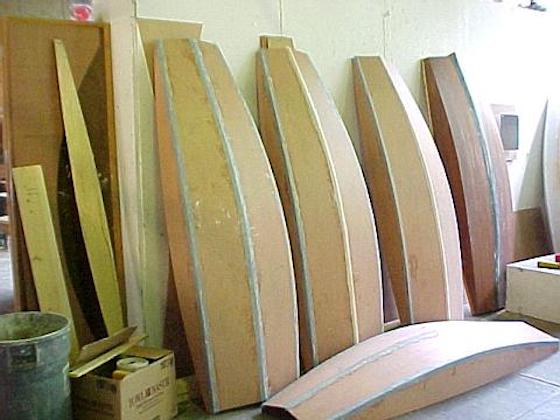
The Mouse is one of the most compact and nimble boat plans we have found for this list. It is an easy build and also a great boat for two kids or a single teenage paddler.
The original builder began with a one-sheet boat design in an effort to create the lightest and most affordable boat possible. This means it is only suited for calm waters and should not be used in high winds or wavy conditions.
That said, it was built in roughly 12 to 24 hours of work time and doesn’t require a full workshop to construct. The main material that is required for building this boat is quarter-inch plywood. But the builder recommends using one-inch by half-inch pine or something a little sturdier.
The plywood and pine components are held together using a method called ”˜stitch and glue’. This method requires choosing one of the best glues for kayak outfitting , which are typically made of epoxy and glass tape rather than something cheaper like polyurethane.
The Mouse Instructions
Also, here are a few extra useful The Mouse Notes for builders
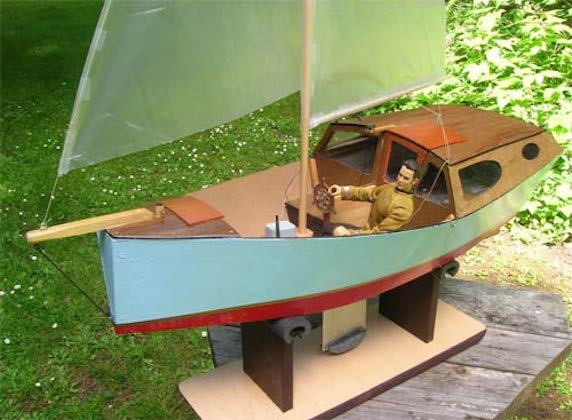
The Slipper is the first of many sailboat plans on our list and it is faster, easier, and cheaper to build than most. It also features a deeper cockpit than many other sailboat designs, which makes it safer for intermediate sailors.
This sailboat plan features dual steering stations so that you can sail from inside or outside of the helm. It also includes a centerboard trunk that hardly intrudes into the cabin at all. So that, it is easier to work around while you are in the cockpit.
The exterior hull and cabin of this sailboat feature a modified dory design using two sheets of plywood ripped to three feet wide before being joined together. The resulting hull is a modified V-shape that reduces drag.
The centerboard of this boat can also be winched up to the level of the top of the cabin or lowered down to alter the draft. This allows you to customize the boat design for a stiffer and more weather-worthy vessel if you need it.
The Slipper was also intentionally designed with an aft cabin that naturally helps to keep the bow pointed into the wind whether you are underway or the boat is anchored in the port.
The Building Slipper

PC DIY Wood Boat
The Handy Andy is a great little 10-foot portable rowboat for hunting, camping, fishing, and other recreational uses. It is actually the only folding boat design on our list, which makes it best for folks that need the most portable boat plan possible.
This boat features a 42-inch beam and a depth of about 15 inches at the mid-section. It also weighs roughly 80 pounds when assembled and can handle up to three average-sized human passengers.
The design boasts a flat bottom with canvas-bound edges and the primary material used for construction is ⅜-inch marine-grade plywood. Despite its lightweight nature, this rowboat can handle trolling motors or even outboard motors with a maximum of five horsepower.
Once finished, the hull can be folded or unfolded in less than a minute’s time.
This design makes it one of the only boats on this list that can be stored in a truck bed or easily carried by two people to be launched at more remote locations.

If you are looking for an all-purpose dinghy that can handle almost any use you might imagine, look no further than The Junior free boat plan. It can carry three or four average-sized adults and is much easier to row than a traditional dinghy.
It is also durable enough to be equipped with a small outboard motor. You could even set it up with sailing equipment if you want to use it as a sailing vessel. As we said, this is truly an all-around boat design!
This boat plan requires constructing three frames that will provide the majority of the load-bearing support. The builder recommends using ¾-inch framing with ⅜-inch plywood as the exterior material for this boat build.
Resin glue and flathead screws are also required to hold this boat together. But there is a full list of materials included in the plans we have linked to below. Sticking to that plan should also give you enough leftover materials to construct two six-foot oars for rowing this boat until you install a trolling motor or outboard motor down the line!

Channel your inner Captain Morgan when you are following these plans to build your very own Jolly Roger boat. This flat bottom boat design is designed for pond fishing . It can also be a useful yacht dinghy for getting from your dock to a larger vessel anchored offshore.
The plan follows conventional dinghy construction methods but also includes a few modifications that will save you time and energy. The wide design is super stable for boaters of all ages.
The keel, frame, chines, and risers are all cut from ¾-inch oak, ash, or any other trusted hardwood you can get your hands on. For the smaller components, the builder recommends using cedar, cypress, fir, or white or yellow pine.
Because this boat plan is also sturdy enough to handle a small motor, it includes important points for protecting the wooden hull from spark plug damage.
Be careful to follow these guidelines to build the safest boat possible if you imagine installing a motor down the line.
The Jollyroger

The Cork is another simple rowboat design. This one trends away from the flat bottom plans that we have included thus far. Instead, it features a deeper, V-shaped hull that makes it better suited to more efficient rowing and easier maneuverability.
It can be rowed easily from either seating position and is durable enough to handle up to three average-sized adult passengers. The ends of the boat are identical, which allows for multi-directional rowing.
The list of materials required for this boat plan should cost you between $30 and $50, depending on your location and hardware costs there. The resulting build is lightweight enough for two people to be carried and also to be transported on top of a vehicle .
Inside the boat, the builders use aluminum tubing to secure the struts that hold the seats. This material choice keeps the overall weight of the boat down while still adding the necessary rigidity across the beam of the boat.

The Hobie Cat is one of the most iconic and recognizable small sailing vessels ever made. This Hobby Kat plan is your answer to building your own iconic sailboat without spending thousands of dollars.
Your finished boat will be able to handle speeds of up to 20 miles per hour. It will be a super fun vessel for windy days on the lake or bay. The builder was able to construct the hulls, decking, and rudder for this boat while spending little more than $200.
From there, they purchased and installed the mast, boom, sail, and rigging, which brought the total amount spent to roughly $650 (still much less than a name-brand Hobie!). Without the mast and sail, this boat weighs roughly 165 pounds and is constructed using primarily 3/16-inch marine plywood.
You can also elect to build your own mast, boom, and sail if you have the time and skills to do so.
Those elements are not included in this boat plan, but they do offer some recommendations for where to buy these components!
The HobbyKat

Named after the common seabird found around the world, the Tern is a lightweight and nimble sailboat with a 72 square foot base design. She is made for inland sailing and planes very well in moderate breezes.
The hull design also provides minimal water resistance and the small floor plan makes this boat easier for intermediate sailors to handle. Even though it offers a small footprint, this boat is sturdy enough to handle up to four adult passengers.
One of the best things about this boat plan is that it can be built almost entirely by using only common hand tools.
Of course, you can speed things up if you have power tools and you are skilled enough to use them correctly.
The Tern boat plan includes a 20-foot mast, but you can shorten that length if you desire. The plan includes a complete list of materials and step-by-step instructions on how to plane and assemble each element.

As you might expect from its name alone, the Falcon is an incredibly speedy sailboat for its size. It boasts a 14-foot centerboard and can handle two to four passengers, depending on its size and weight.
In tests of the original build, the creators claim that this boat out-distanced many Snipe and Comet sailing vessels as well as pacing evenly alongside longer 18-foot sailboats. When finished, your boat will have a six-foot beam and a total weight of roughly 475 pounds.
For the main framing components, they recommend using white oak and plywood will be the main material used in the hull construction. The hull features a V-shaped that was inspired by larger schooners.
The Falcon is best suited to sailing on bays, lakes, and wide rivers. It is also a boat plan with just under 120 square feet of deck space and it is a great build for amateur craftsmen and sailors.

The White Duck is a flat-bottomed rowboat with a total length of 13’6” and a four-foot beam. The cockpit is approximately 15 inches deep all the way around and this boat can handle up to five passengers while maintaining buoyancy and stability.
When fully constructed, it will weigh roughly 200 pounds, but the final weight will depend on the type of lumber you choose for your build. This boat plan features plywood planking over solid wooden frames.
The White Duck is built with a pointed bow that cuts nicely through the water. The flat stern of this boat design will make it easy to attach a small outboard motor with a maximum of six horsepower.
As you might expect from its name, this rowboat is a great option for duck hunting trips. That being said, it is a highly versatile craft that can also be used for pond fishing or casual rowing on your nearby lake.

The Sea Midge is one of the smallest rowboats on our list and it is ideally suited for one average-sized rower or two small paddlers. It is only about 8 feet in length and offers a 52-inch beam at its widest point.
The Midge’s small dimensions make her ideal for navigating narrower creeks and streams. With an approximate weight of 62 pounds, she is easy to maneuver on the water and can also be much more easily transported than some of the larger boat plans on our list
The Seamidge

The Zephyr is a compact and speedy dinghy sailboat that measures roughly 14 feet long and approximately five feet across. This boat style was originally developed for safely crossing the English Channel. This means it can stand up well in rough waters.
When finished, it is also light enough to be transported on a small trailer or on top of a larger vehicle.
The boat plan calls for using hemlock or fir for the framing and oak or Douglas fir for the keel and chines.

The Gypsy is a small cruising sailboat that is meant to be equipped with an outboard motor for powered locomotion. The original design resulted in an incredibly seaworthy vessel that logged more than 6,000 nautical miles in her lifetime.
It includes a comfortable cabin that makes it well-suited for multi-day sailing adventures. This boat plan includes improvements on the original design that will help you build an extremely durable and long-lasting sailboat.
The Gypsy boat design will help you construct a vessel that can handle a motor up to 25 horsepower so that you can enjoy cruising speeds of up to nine miles per hour.
While it may require a bit more of an investment in time and money, it will also help you produce one of the best boats you can build with a free boat plan!

PC Saint Dominic Catholic School
Finally, let’s talk about a crazy cardboard boat plan that you can build in less than a day. This is a great boat plan to bookmark for your next teambuilding project so that you can earn bragging rights with your coworkers.
The plan calls for using 1.5 sheets of cardboard. But you can use the remaining half sheet to build your own boat paddle if you want to get creative.
Triple-thick cardboard is best for this boat plan. But you can always double up thinner sheets if that is all you can find.
These plans include an easy-to-follow diagram for marking, cutting, and folding the cardboard sheets to create the hull of your boat. From there, it calls for using contact cement and construction adhesive to seal the edges and corners.
If you are looking to save a little money on this build you could also use duct tape and then wrap the entire design in plastic sheeting to provide waterproof qualities.
Overall, this build is one of the cheapest and easiest on our list. It is also a great project for hot summer camp days on the lake or river!
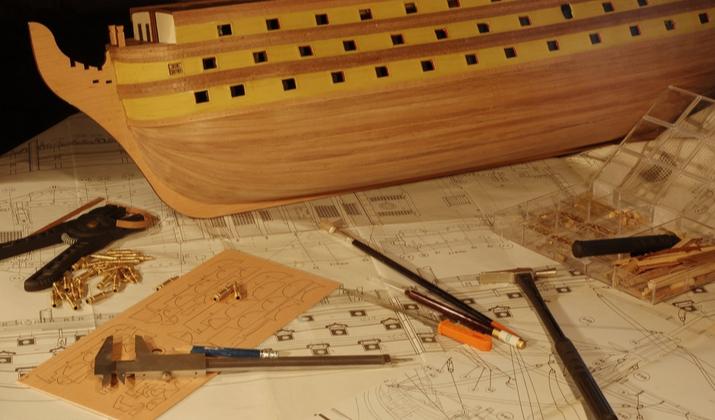
Photo by Alexandra Soloviova via Shutterstock
We hope that you now have a couple of free boat plans to inspire you to begin your own construction project.
Don’t hesitate to check out YouTube for some useful boat-building videos when you are getting into the nitty-gritty of these build processes!
Enjoyed 15 Free Boat Plans You Can Build This Week (with PDFs)? Share it with your friends so they too can follow the Kayakhelp journey.
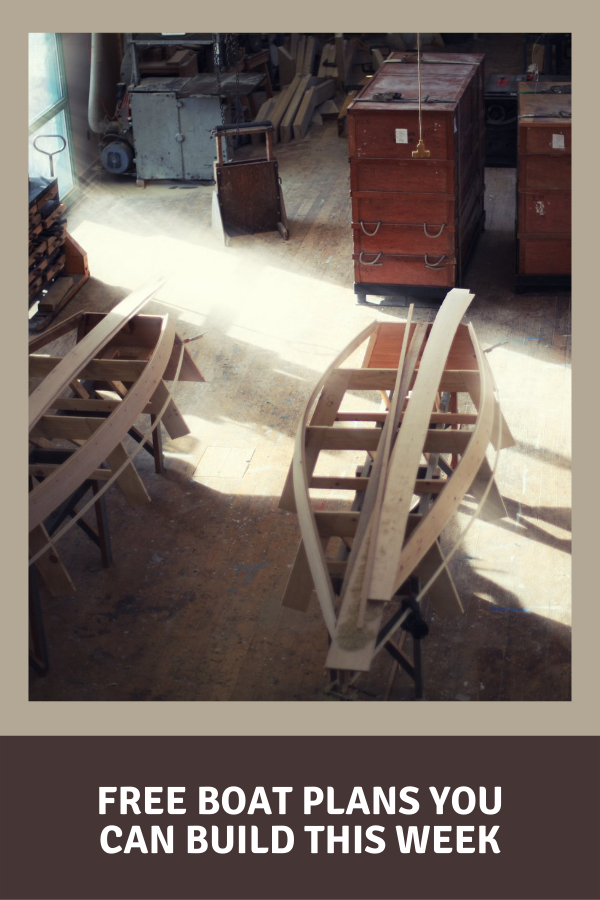
Peter Salisbury
Pete is the Owner of KayakHelp.com. Born and raised in Cleveland, Ohio, he grew up kayaking, fishing, sailing, and partaking in outdoor adventures around the Great Lakes. When he’s not out on the water, you can find him skiing in the mountains, reading his favorite books, and spending time with his family.

LIST of WOODEN BOAT PLANS – By Michael Storer
Plywood boat plans and wooden canoe plans. sailing dinghy . power . row . paddle . overnight, a boat building course in a book.
Click on an image for more information about our inexpensive, highly detailed boat plans and wooden canoe plans
Viola 14 Sailing Canoe Boat Plan
A sailing canoe to make dinghy sailors happy – 75lbs and for a simple boat, beautiful beyond belief – visit page.
Viola 14 Sailing Canoe is fun and exciting. But easier than a sailing dinghy to transport and store.
Canoe performance and Dinghy stability. 14ft – 75 pounds (34kg)
Viola is extremely stable allowing the crew to stand up and step and unstep the lug rig mast while on the water. Try that in a symmetric paddling canoe hullform! If righted correctly she is almost dry after capsize.
Three Sailing rigs with two piece masts 4.7 and 6.0sqm full batten rigs. 6.3m balance lug with three reefs for distance sailing. 75lb hull. Four sheets 4mm plywood.
More about the Viola 14 Sailing Canoe Plan here
Kits For Viola 14 Canoe Europe – Viola 14 Sailing Canoe Precut Plywood and Timber Kits Americas – Viola 14 Saling Canoe Precut Plywood and Timber Kits
16ft Kombi Sail and Paddle Canoe Plan
A 50/50 Sail and Paddle Canoe for one or two with more stabililty for sailing – visit page
The Kombi Canoe is a development of our recent sailing canoes to bring paddling ability up equal to the sailing ability.
Great for families as it can be used as a pure paddling canoe, but also sail well with one or two adults aboard.
More about the Kombi Sail and Paddle Canoe here.
NEW Plan – Mini Outriggers for Adding stability to sailing canoes and small dinghies
The Mini Outriggers are to add stability to a sailing canoe or small dinghy and aid stability to reduce the risk of capsize on other relatively slender boats.
They are set above the water to allow a sailing canoe or narrow dinghy to be sailed normally .
More about the Mini Outriggers here.
Taal Stand Up Paddleboard in Plywood
Both speed and stability at the same time.
A beautiful plywood Stand Up Paddleboard designed for distance paddling.
The user feels the stability, the water thinks it is a low drag pintail. 12ft
We created a board that hits the numbers for a good canoe or rowboat. Less wetted surface with a stable midsection and excellent weight carrying.
12ft and Stable for beginners but with the low drag of a kayak/pintail type hull (see the stern photos).
More about the Taal Touring Stand Up Paddleboard Plan here
Goat Island Skiff Sail Boat Plan
Simple, modern performance and famous worldwide.
Justifiably famous.
Simple to build but light, fast, pretty. Fast with 1 to 4 adults
Rows and Motors and will sail rings around other character boats. 15.8ft
More information about the Goat Island Skiff Plan Facebook Group for asking questions about the Goat Island Skiff
Quick Canoe 155 – build in 2 weekends
Very simple plywood canoe that handles well and looks right.
Quick DIY wooden canoe that works better than most flat-bottomed canoes and many fibreglass ones.
Even looks good on the beach. 15.5ft
First one took the builder 4 1/2 hours to get on the water – but most take 2 weekends. Half the weight of many fibreglass canoes. Lighter than most plastic. 55lbs from big store plywood. Another took 5 1/2 hours .
It has been designed to be as easy to build as possible while keeping most of the qualities of a nice paddling wooden canoe.
In particular the ability to track – excellent first boat plan. Click here for a comparison between our fast and our classic paddling canoe plans
More Information about the plywood Quick Canoe Plan
Eureka Canoe – Classic Plywood Canoe Plan
Light and lovely to paddle. simple plywood boat plan.
Light on the land, Prettiest Plywood or wooden Canoes anywhere. 15.5ft
Excellent distance touring boats.
15’6″, simple construction for a wooden canoe. 32 – 45lbs (15 to 20kg)
Click here for a comparison between our paddling canoe plans.
Click here for more information about the Eureka Plywood Canoe
Quick Canoe Electric Cargo Canoe Plan
Wooden cargo canoe for electric trolling motor 34lbs thrust.
5 to 6mph using a 34lb thrust Minn Kota or other electric trolling motors. DIY plywood canoe for fishing and roof racking.
Keeps the simplicity and low materials cost of the Quick Canoe Family. 15.5ft
Cartop transport. Very detailed Wooden Canoe Plans.
Click here for more information about the Plywood Quick Canoe Electric
Oz Goose Light Family and Club Sail Boat Plan
Low-cost family sailing dinghy, regattas and club training and learn to sail.
The Oz Goose is a small boat that is super easy to build.
Cruising or teaching with three adults or excellent club racing performance sailing with 1 or 2 in the boat. 12ft
The famous line is we can build 10 of these in the Philippines for the price of importing a single Laser sailboat. Boat speeds are very matched for excellent tactical racing when not heading off for a family picnic with two adults and a bunch of kids aboard
For training, the goose will carry an instructor and two adults to sail with good sensitivity and speed. In stronger winds, we commonly see downwind speeds of 10 to 13knots and sometimes much more.
Also, visit the Oz Goose Group on Facebook More information about the Plywood Oz Goose – see the website
“BETH” Sailing Canoe – Elegant plywood boat plan
Simple, brilliant performance – one person cartop – sailing canoe portability.
A touch of the 1870s but fast about as much fun as is possible on a plywood boat.
Yawl Rig with speed – a wooden canoe that can scare the Lasers at your local club .
Racing dinghy experience recommended!
A small boat for amateur boat building that is light enough for one person to roofrack 70lbs plywood canoe hull. Sailing Canoe boat plan
Click here for more about the plywood BETH Sailing Canoe Plan
Drop-in sail Rig Plan for Canoes and Kayaks
Convert a canoe or dinghy into a serious sailboat.
Convert most Kayaks or Canoes into an INSTANT SAILBOAT.
Everything removes as one unit except for the mast step
Also fits some rowing dinghies that are small or narrow.
Very cheap beginners plan.
Read more about the Drop-In Sailing Rig Boat Plan
Drop in Outrigger Canoe conversion Plan
Convert canoe, kayak or dinghy to a fast sailboat trimaran with amas..
Create a paddle or sailing outrigger canoe from a fibreglass or wooden Canoe or Kayak.
Even an elderly Grumman!
Convert your old canoe into an awesome sailing machine or fishing or diving platform.
Each component is under 10 pounds and everything removes cleanly from the boat apart from 4 small fittings and a mast step.
These Amas and crossbeams work for fibreglass and wooden canoes and dinghies, Fibreglass, Aluminium and some plastic canoes.
Performance sailing (see the video on the plan page ) or as a stable fishing platform or to make a super quick sailing multihull.
If you buy the plywood boat plan for the outriggers there is a free supplement available to set it up for sailing. Very cheap plan for a big boost in performance.
Find out how to convert your canoe, kayak or dinghy to a fast sailing outrigger canoe
Handy Punt – simple fishing punt Boat plan
Light cartop load, simple to build and stable – ideal first plywood boat plan.
Outboard motored Punts are the simplest plywood boats.
Good performance, easy construction, stable fishing platforms.
And lightweight for cartopping on roof racks.
An easy first boat plan for first-time boatbuilders.
6 to 8hp – 10 in some regions
Click here to find out more Outboard Punt Boat Plan
Russki Wave Ski, Surf Ski, Sit Down Paddleboard Boat Plan
Easy to build sit down paddleboard from two sheets ply.
Simple plywood waveski or paddleboard from two sheets of plywood.
Paint it and keep it on the car roof ready for use after work.
Small light boats usually are used more frequently than complicated and expensive boats.
Find out more about the Russki Plywood Wave Ski Plan
15 1/2 ft Storer Rowing Skiff Plan
Easy pretty plywood rowing skiff plan for oar.
Simple lightweight rowing skiff for one person and maybe a passenger based on the Goat Island Skiff.
Or Adult and a couple of kids.
Pretty and quick rowing boat on the water.
Simple lightweight rowing skiff for one person and maybe a passenger or a couple of kids. Based on the Goat Island Skiff. I used to get enquiries about using the Goat Island Skiff sailboat hull for rowing. It does row well but blows around too much.
This is much, much better. Pretty and quick rowing boat on the water.
Find out more about the plywood Rowboat Plan
Dayboat/Launches Boat Plan Bundle 23 plus 27ft (7/8.4m) Venezia
Boat plans for two simple prefabricated cruisers for low power outboard in one package – 23 and 27ft.
Picnic boat, party boat, river-cruiser, camp aboard, mini home-away-from-home.
Cuts through river and lake chop with zero bouncing and pitching.
Pack includes 23 and 27ft Dayboat versions in one plan pack includes Venezia below.
Simple plywood construction. 10 or 15hp 4-stroke for 8 to 10 knots. Venezia and Dayboat Launch Boat Plan Package
More about the 23ft Plywood Dayboat/Launch Boat Plan
“Venezia” 27ft trailerable canal boat
Stretched version of 23ft – both included in the plan above.
An 8.2m (27ft) boat for gentle cruising in rivers and canals.
Great appearance, sleeping accom., separate toilet – your layout.
10 to 15hp 4-stroke. 2 wooden cruising motor boat plans for the price of one – Venezia and Dayboat Launch Boat Plan Package
Read more about the 27ft Venezia cruiser canal boat plan
TC35 Riverboat – Prefab, Economical Liveaboard for Two
Minimal liveaboard plywood boat 35ft.
Very economical, near wakeless cruising motorboat.
Light on the gas and light on building materials.
Revised wooden boat plan for an extremely economical, efficient low horsepower riverboat.
35ft. 1 x 15hp or 2 x 10/15hp. Simple Prefab Plywood Construction.
Find out more about the TC35 River Cruiser Plywood boat plan.
OZ RACER – 8ft Sailing Dinghies.
Smaller versions of the 12ft oz goose sailing dinghy – 8ft for easier storage..
12ft Oz Goose for Capacity and Performance
- Same easy construction
- Same Sail and Foils
- Much higher performance
- Much larger capacity
OzRacer RV 8ft – General purpose version
OzRacer RV is the same small boat hull but with more space in the cockpit and is a slightly simpler build.
4 sheets plywood.
These Boat plans are a modern boatbuilding course in a book. Capacity 1 adult and one child or maybe 2 adults
Find out more about the OzRacer RV
OZ RACER Mk2 8ft – Race Version
OzRacer Mk 2 has a centreboard for more performance but a bit less room for extra crew.
Three sheets plywood. Simple Plywood Boat Plans. Capacity 1 adult and one child or maybe 2 adults
Find out more
Free plans Oars and Single Paddle & Double paddles.
Simplified paddles and oars based on classic designs – free plan.
- Free Plans for Wooden Oars
- Single Paddles
- Double Paddles.
I didn’t want to charge extra for nice paddles to go with our nice wooden Canoe plans
Download Free Oar and Paddle Plans from this page.
Tips and Tricks for Boatbuilding, Woodwork, Use of epoxy.
CLICK HERE for many helpful articles about the selection of materials, boatbuilding and boat repair techniques. All to help home boatbuilders.
The Master list of Articles we have written to explain and help out home boatbuilders
Blog Articles about a whole range of design, building, sailing technique articles.
57 thoughts on “LIST of WOODEN BOAT PLANS – By Michael Storer”
Dear Michael Storer, After purchasing your design of the Viola 14 I am in the process of building now and looking for the sail plan for the 6.3m lugger sail which is not in the building description. Can I find the sail plan somewhere on the website or can I get it in another way? Thanks in advance and best regards, René
For these sorts of questions it is best to use the email on the cover of the plan set or the facebook group. https://www.facebook.com/groups/storerboatplans/
But having seen this now I will send this to you.
Best Regards Michael.
Hello Michael,
it is possibel to get a Plan from your Goat island Skiff but 50% bigger and with a standard Rigg with Fock and main sail ?
Best regards Volker
No, I am a afraid it isn’t possible. It changes so many things that it becomes a new design. I choose new designs on the basis of how many I feel I’m likely to sell. I am interested in designing a bigger boat but it won’t be for some time. Maybe years. But there are other excellent designs that may suit your needs. Have a look at B & B designs. Similar performance type but already bigger and with and without a cabin.
Best Regards
Hello,, Michael, I am interested in building a hull like your Handy Punt, but at a length of 14 to 16 feet and a maximum width of 5’11”. (48-inch width would be adequate.) These dimensions are dictated by the covered slip where the boat would live. I will customize the interior for fishing in a 100-acre lake that does not allow gasoline motors. It can be lifted by an electric hoist for storage. Power would be a Minn Kota bow-mounted trolling motor with 80 pound thrust. It would be laid out for two-person fishing. Pilot would sit in the front to steer motor and consult bow-mounted sonar. Passenger would be in rear on chair or bench. It would need two 12-volt marine batteries. Could this work?
Increasing the length doesn’t really create any significant problems if another bulkhead is put in somewhere.
But increasing the beam creates all sorts of structural loads not anticipated in the original. It would no longer be a Handy Punt, but an original design from you. That’s not necessarily a bad thing – but there are risks involved.
Cheers Michael
interested in building a handy punt catamaran using an enlarged ozgoose plan 16 x 4 making the air chambers 2 x16 for the pontoons for a outboard motor of fairly low hp I am thinking 20 hp
It is possible to modify plans.
Yours is either the glory or the recriminations – or possibly both :)
Hi Michael Do you have any 17ft plans for coastal camping and cruising? David Australia.
I don’t.
I would suggest looking at John Welsford, B and B yachts and Iain Oughtred designs.
All good designers of very different styles of boats.
hello Michael,
would you be the man formerly behind Q-Craft ? If so, can I get your advice regarding the 3-person canoe model. There’s a used one for sale nearby and our buying decision based more on price than anything else. Being fibreglass, weight’s the prob but I’ve owned the same Canadian type many years ago so know what we’re in for at least. Solely calm waters intended for our paddling Appreciate your feedback if appropriate
I’m afraid I have never had any connection with Q-craft.
Hey Michael,
I recently bought your GIS plans, and then I found out that you may have a smaller version in the works. Will that be available any time soon?
Hi Rick, No, the timeframe is quite long term to get another plan fully documented. Probably 100 pages to write, lots of illustrations, drawings etc
God day Michael ! I am following the VUELTA (cycling Tour of Spain) and I enjoyed for 10 mn ago seing the young Australian Michael Storer winning the very hard “etape” (day competition). He had to climb the last mountain with two others guys 100 yards back and the suspense was terrible until the line, but this Aussie was a tiger today. Conclusion : two Michael Storer on top of the wave in Australia now ! (I enjoy your boats and I love Australia – living in Cottesloe, Perth, in the last century).
Thankyou Yves!
I don’t actually have many namesakes. For years the only Storers in the Sydney phone book were my family and my Aunt.
But other Storers have clearly been more (re)productive!
Best Regards and thankyou for the kind words.
Hi Michael I’m finally (FINALLY!!) building the Eureka Canoe. I purchased the plans way back – this is the set from 2006 (!) – but I wanted to check the temporary spreader dims for the higher volume boat. In the plans I have, it’s middle spreader = 857mm, and 2 end spreaders = 646mm. What are the higher volume dims?
Hi Richard … Send you an updated copy. Ah … was good fun living in Adelaide!
Hello, I have decided that my next boat to build will be a Shanty Houseboat as a retirement project, some place to live and be near fish, ya know? But, my journey in boat building started back somewhere in 2005 in Balad, Iraq. I was deployed at the time and was having severe anxiety so I did some meditation to calmer, more serene places and times, which eventually led me to a particularly fine memory of about 10 yrs old. Then, I was the middle child of 3 to a single mother on welfare, which did not afford many options on luxury or entertainment. I am sure you’ve heard the tale a thousand times already… I had a friend, named Eddie Dean, who’s Mother had a boyfriend who wanted to take her sailing. Being a single mother also, she couldn’t leave the kid behind, so they took me as a playmate. I had never been on a “real” boat in my life up until that time (a couple of ‘canoes’ at Six Flags, maybe.) I cannot even tell you the color at this point. But we went sailing, night sailing also, and it was a hidden, joyous memory for me! Fast forward to the war, and I find myself struggling for sanity in an insane place. I find that gem and I latch onto it like nothing else, this was my ‘safe’ place! I order “Sailing for Dummies” from Amazon, Sailor-talk Flashcards, and a book on knot-tying. I am determined, I am going SAILING again!!! Yet, I am in a desert and don’t have a boat… So, when I rotated back to the World, I do research and find the PDR, easy enough. Then I find the OZ version of that boat, which is the FIRST boat I built! Before this, the ONLY thing I had ever built out of wood, was a lopsided bookshelf in 8th Grade woodshop. A truly tragic abuse of wood, in hindsight. Your plans were straight forward, easily read and thorough. It was an immense pleasure to craft something from nothing. I took a month on it because I did not understand some terminology. More research… Once she was built and rigged, I still didn’t have a name. I floated her on the south marina of Willard Bay, Utah and dubbed her “OMGIF” (Oh My God, It Floats!) Afterwards, I applied all the book learning and taught myself how to sail. It wasn’t all peaches and cream, I had underbuilt some things and over estimated my skill A LOT! But, it was a GREAT beginner boat! I even taught all the “feral and orphan” children (this is a generic term for ALL kids that are not mine) around the neighborhood, those that were willing to learn, how to sail. I eventually gifted the boat to the prodigy for his 10th birthday. Since that first incursion into boat building, I have built 3 more: 2 day-sailers and a sloop, cabin cruiser, which I now currently own NONE! My ex-wife would let me build them, but not sail them. She is NOT an issue anymore
So, to make a short story long, I have been searching for a tender- type fishing platform for the Shanty I will build. I am quite excited about the prospect of a 12′ OZ sailer to fill that function, and I cannot wait to start building!
You do good work Sir, I thank you for it!
PS. Not that it really matters, but I posted on the PDR website 2 records the year I built my OMGIF: Highest Elevation and Fastest Speed. Was quite proud until I realized that I was the ONLY person that posted that year. So, to cure my depression, I also posted a PDR World Record for the Pinkest Boat! (mine was green…)
That is all excellent!
Congratulations on your records!
We have a great and active Oz Goose group on Facebook – if you use facebook. https://web.facebook.com/groups/opengoose/
Hugely useful.
Best Regards and Good Luck with the next project
Hi Gary, Wayne, Michael – I am also interested in outriggers+Kombi. has anyone pursued this idea? If one were to go down this route, are there any design considerations that need to be in mind from the beginning? Is the only real change to the Kombi increasing the mast diameter to 60mm? With the increased stability of the outriggers, is there any merit to considering the larger rig from the Viola instead of the standard Kombi rig? Or would this throw other things out of balance? Thanks, Colin
There are other ways to go with outriggers.
The idea from Solway Dory of smaller hulls gives a lot more reserve stability – plus they can be kept out of the water most of the time for a negligible effect on performance.
the mast would not need to be changed over either.
Look up the Solway Dory Outriggers on Google and see what you think. This is also a better topic for email.
hi Mik Following Garys query about outriggers for Kombi and/or Viola. I have been thinking for a while about an rooftoppable allrounder for our extended road/camping trips in the campervan. So all in protected water, two septigenerians with one “boaty” and one a “tourist.. Single or tandem paddling (rivers estuaries and such) Sailing (safe not high performance) Fishing.(again safe platform) Of course such a wish list threatens to result in something that doesnt do anything very well. When Viola appeared I thought this could be it? But a bit wide for paddling, a bit flighty and a bit heavy. The along came Kombi! And I already have your drop in outrigger plans…Perfect! Could you perhaps suggest a layout for a Kombi Tri including any hull mounting reinforcement. As we age needs change and I am going to jury rig a couple of amas to the GIS this summer as a proof of concept experiment. I hope thats not too “rude”. The Kombi Tri I would build as a package , concept already proved. Thanks Wayne Fremantle
The Kombi is the boat for this use pattern. Mast diameter will have to go up to 60mm to handle the greater stability from the outriggers.
I would suggest setting up two spreader bars set the same distance apart as the outrigger crossbeams with the mounting points for the outrigger tie downs just behind the spreader bars.
For hull mounting reinforcement for the crossbeam tie downs a piece of ply at each point 50 wide by 75 to make a pad for through bolts and a “saddle” or “deck eye” using 3/16″ Bolts (or 5mm metric).
I think it would be quite a satisfactory boat. I would definitely carry paddles as I suspect the tacking technique will be like a roll tack for the standard Kombi so it will spin fast. With the outriggers it may be a bit sluggish … or maybe it will be fine. Also there is a free supplement written for buyers of the outrigger plan to alter the crossbeam curve to match canoes with lower freeboard. That would match the Kombi too.
Mr.Storer, I am thinking about combining your drop in outriggers with either the new Combi or the Viola sailing canoe. Has it been done? Your thoughts? Thanks, Gary Moore
Hi Gary, It will put a lot more load on the hull because of the large increase in stability.
It might be OK. The mast diameters would probably need a slight increase.
Hi I’m interested in the possibilities of cruising in a Goose and sleeping under a boat tent, for which the rectangular hull would be very well suited. Would it be possible to move the daggerboard case to the side – even against the buoyancy tank, perhaps – and narrow the bottom of the frame so it doesn’t dig in to your legs, in the interests of comfortable sleeping? Thanks.
There are some options.
If you have facebook, Thomas Newton made some changes that seem to have worked out well removing the need for the centrecase bulkhead and associated seat.
https://www.facebook.com/groups/1622720037971725/search?q=thomas newton
Hi, Michael !
I am interested to learn how many plywood sheets go in 27ft Venezia and 35ft TC35 builds. And also the TC35 resulting hull weight estimate. Can you share on that?
Kind regards, Aleksei
Hi Aleksei,
Here are the plywood quantities.
12mm x 2 9mm x 57 6mm x 4 4mm x 1
– there will be some variation here as the interior layout can be changed substantially by each builder. 12mm x 1 9mm x 20 6mm x 28 4mm x 3
Best wishes Michael.
Dear Michael,
I wish to build a Mundoo electric boat for european canals, but I can’t find the plans. Is it available? Thanks in advance,
Pal Horvath
You need to contact DuckFlat Wooden Boats in Adelaide Australia.
Their website is duckflatwoodenboats dot com (change the dot to a . and remove the spaces)
I was simply employed as a draftsman for that project. It is not one of my designs.
Thanks for the reply Michael.
I’m actually one step ahead and already had a good look over your pages of sailing tips! Really good stuff that simplifies everything considerably, especially in regards to point of sail.
The reason I chose the RV was purely for space reasons. I figure that if I ever get to a point where I’m longing for the extra size of the goose, I can always sell the RV and build a goose. I’ll never turn down the chance to build something.
Another question I had was in regards to whether the RV is suitable for roof rack transportation? I couldn’t find any info on the weight of the RV and whether this would be a viable option. Not having to buy a trailer would also cut down on costs :)
No problem at all with the principle of cartopping the OzRacer (or the Goose).
It can be tricky to find roof racks for some modern cars that can handle even the 70 odd pounds of the OzRacer RV hull. But if you can do that, then no problem.
Hi Michael,
I’ve never sailed before, however i’ve recently taken an interest in sailing after coming across various youtube videos on boatbuilding. I then went down the rabbit hole and started digesting countless books, researched terminology and watched demonstrational videos. However, I obviously don’t have the practical experience.
I’m particularly interested in the Oz Racer RV, mainly due to the simplicity of the build, but also because I can easily store and transport the boat. This also seems like a great beginner boat.
My big question however is would you recommend I take sailing lessons before building and sailing the RV? I don’t have a lot of money, so i’m in a bit of a dilemma about whether I spend money on learning to sail or building the boat and teaching myself to sail through research and practice alone.
Thanks! Drew
Sailing lessons don’t hurt at all.
But I would also have a careful look through the basics of my online lessons as they are closer to the state of the art than many sailing schools.
There has started to be large difference between what is taught and what the best sailors are using.
The importance is that the methods of the best sailors actually make sailing easier and make it easier to extend a beginner/intermediate sailor into the stronger wind ranges.
Many courses have moved with the times. But many have not.
Also, have you considered the 12ft Oz Goose. http://opengoose.com/plans/oz-goose-2016-plan-now-available-from-our-agents/
The biggest reason for choosing the shorter OzRacer 8ft is the storage after building. The cost is only a little more because the sail and everything above the decks and the fittings etc are all identical. Building difficulty and time is identical too – about an hour different actually)
Hi Michael, Thanks for your prompt reply. I replied yesterday but had issues with my browser. Anyways a putt putt boat is fine and the ability to trailer the boat is paramount. Getting down around southern moreton bay or the Noosa river, lake Cootharaba. Do you know of any builds in my neck of the woods, sunshine coast. Kindest Regards Tony
Hi Anthony,
There are/were two in South Australia on the Murray River and lakes and one in NSW on the Hawkesbury River .
But none in Queensland as of yet.
Hi Michael, Would your Dayboat come launch Venezia handle Moreton Bay. That is the water from say inner Bribie Island through the Moreton Bay Islands to Runaway Bay?
Kind Regards Tony
With the high thrust 10hp Yamaha it has substantial grunt. But despite the cabin you really need to think about it in terms of being like the old open Putt Putts.
There would be conditions that would be unwise to go out in, but plenty of conditions and parts of the bay that would be available as they are quite protected.
It would start to get tricky heading up to the North part of the Bay parallel with Moreton Island with one of the strong North Easters. But down toward the South you would just pick the location relative to the water conditions on the same day.
Best wishes Michael
hi Michael .way back in 1979. I bought plans for optimus maximus from you. I got to the frame complete stage, then a friend took over construction. as I moved to australia, He and his 3 boys finished and sailed it Often beating my brother and his sons in their bought sail boat. and had a lot of fun in the process
I think Optimus Maximus was designed by my friend John Welsford.
I will send his contact details to your email.
Best wishes. MIK
Hi, so it’s me, my wife (who is not a huge fan of sailing), and our 3.5 yr old son.. I’m trying to figure if I should build a eureka canoe for our family outings, and then the amas and sail rig for me to sail .. or.. go for the Viola 14 and hope we can all fit for short outings on lakes and ponds.. could we all fit for a paddle in the Viola? Also, how does sailing performance compare with Eureka and amas, vs Viola? With this crazy pandemic, seems like a good time to build a boat out in the carport!
The Viola will be OK while your son is really small. I designed it around being optimal for one adult. But I left enough margin for decent sailing performance with two adults providing they are not too large. Maybe it tops out at around 350 pounds or a bit more. With that weight it won’t be a great paddling boat but would be fine for messing around in a bay or a couple of miles in good weather with that weight. One up the Viola paddles pretty well, but it not optimum so will drop behind a proper paddling boat.
The Eureka or Quick Canoe would have a much better ability to travel as a paddling boat with the family. If adding the drop in outriggers it makes sense to leave out the central spreader on these canoes and put two spreaders at the same distance apart as the crossbeams of the drop in rig but a couple of inches forward of the crossbeam locations.
As far as performance. The Eureka with outriggers will have a significant and sole advantage when reaching. But upwind and running the Viola will have significant advantages as it is set up like a racing dinghy.
With the outriggers a 60 to 70sf sail seems to be about right. There is one in the free supplement for the buyers of the outrigger plan but we also make one at our sister business Really Simple Sails
The thing with the drop in outrigger setup is that not to fixate on pointing high. Get heaps of speed and then point up without losing the speed. If light winds sit to heel to leeward so the leeward hull is well immersed. Or make a leeboard for the eureka.
Hi Michael, Thank you so much for all the information! The Eureka with outriggers and sailing setup seems like the right way to go I think, especially fur versatility, plus allowing more people aboard comfortably .. One more question.. what type of sail setup do you recommend for the Eureka in the 60 to 70sf range? I’ve seen bermuda rigs and gunter rigs on this type of canoe and outrigger arrangement .. I couldn’t find the specific sail on the sail makers website.. just trying to cost out this option to see if I can afford to add the sail .. thank you! Hope you are well RP
A basic sail is part of the free supplement available to purchasers of the outrigger plan. It provides a mast support built into the front crossbeam a flatter crossbeam curve to suit the Eureka and other boats and dimensions of a homemade lateen sail to be made of polytarp, or even regular sailcloth.
Our partner business Really Simple Sails does a 70sf lug sail. However we are stuck down with quarantine which I think will add a month
to the normal 10 week timeline at this time of year. In Northern hemisphere winter it goes down to 4 weeks. That sail is USD392 at this point April 2020
Maybe that will fit in with your timeline unless you are a very fast builder.
Hi Michael, I’ve got a Laser Radial sail mast and boom setup, and I’m wondering if you thought this could work well on the Eureka canoe with outriggers, with plans on building a leeboard setup. Also wondering if I should go with the larger volume and wider Eureka. Would this sail better with the outriggers? Harder to paddle? Thanks! RP
It will be a bit big as the wind gets stronger but sparkling performance in up to 12knots of breeze. Might be exciting by the time the wind is at 15 and hard to sail in much more than that.
Could trial it with the full rig and then get a local sailmaker to cut some sail off the bottom if it is too frisky and cut a similar length off the bottom of the mast.
Another way, though not very good upwind would be to wrap the sail around the mast a few times when the wind gets up. Though the sail shape will become a big baggy for going upwind well.
There is also a supplement for the Eureka and other canoes as the freeboard can be a bit low for the drop in outriggers. I provide a drawing on request for making a mod and it also includes how to build the upper mast support into the front crossbeam.
Hi Michael, Sorry just one more question about Eureka (or I guess all of your plans in general) Do you mail a full size printed pattern to trace the cuts from? If not how do you transfer the lines to a larger scale from the manual to plywood? Thanks! RP
The plan itself is more like an instruction book for boatbuilding techniques to build the particular boat. Do the steps one by one and you will have the boat.
The method for marking out is super accurate and has a failsafe.
Basically you draw straight lines across the narrow width of the ply sheets at a set interval – dotted vertical lines in drawing below. 300mm apart. Blue is the plywood. Green is the curve of the panel. The dimensions are purple.
Then put the end of the tape on the edge of the plywood and measure along each dotted line (it will be a solid line on the ply). Put a mark at the distances from the edge shown in the plan. After marking the points on the first line vertical line, do the same for the second line and so on to make a series of dots in a curve.
Finally put a thin nail in each of the measured points and use the piece of timber from the plan list as a batten and a pencil to “Join the dots” or nails in this case to make each curve.
If there is an error it will stand out either when you stand at the end of the sheets and look along the line, or the batten will tell you the point is out of place.
If the point is out of place it is very likely a misread or a mismeasure as most of my plans have been corrected over time. But if it isn’t then you can contact me and see if I made a mistake. The CAD plans on the computer are super accurate, but sometimes a dimension arrow can be a little off.
with the article , images of the trimaran canoe – what is the canoe design. Is it a Eureka . If i wanted to build a trimaran canoe, what centre hull design would you suggest?
There are many centre hulls that are suitable. Many canoes as long as you can attach the strong points for the crossbeam lash down points. So almost any variation of wood, fibreglass or aluminium. Plastic canoes may be difficult but some claim great successes with the WEST system G-flex epoxy.
The Eureka or either the Paddling version of the Quick Canoe or the Electric version of the Quick Canoe would all be suitable. s
Good Day- i would like to chat to Michael about some design work. Is there any direct contact info for him many thanks wayne
For which type of waters(salt or fresh) was the Gooze designed? This never occurred to me until someone told me that I could navigate north on the “Rio Grande de Loiza” river and exit out into the sea, turn right, after some time I would see the exit of “Rio Espiritu Santo ” river and turn right again to go south on that river which heads inland or vice a versa (depending on wind directions on that time of the day).
Hi LAlverio,
The Oz Goose can be out sailing any time that other sailing dinghies are out. It can go conditions that are a bit rougher than many conventional dinghies will not handle well.
The goose is very stable and that stability gives it a lot of power. Also if you do capsize the Goose comes back up with no water inside.
This article about sailing in stronger winds and rough water from the Oz Goose Website may be useful for background.
If you mean the Ooze Gooze, the cabin version by Perttu Korhonen it has less capability than the Oz Goose in rough water.
Best Wishes Michael
Hello sir, I am in the process of converting my 12′ wood sailing dinghy to the Oz Goose balanced lug sail. I have purchased from Duckworks the sail and hardware kit and now I wish to build the wood mast, boom and yard. Can you tell me where I might locate and/or purchase the plans for these alone as I don’t need the entire boat plans, just the wood spars. Thank you
I have provided basic information on our Really Simple Sails website for each of the five stock sails we sell through Duckworks. https://reallysimplesails.com/rss-stock-lug-sails-other-boats/
It lists the spar lengths and cross sections in timber for each of our stock sails. It also provides guidelines for Aluminium or timber spars.
If you need details on how to actually make the parts (and a lot more including accurate foils) the Oz Goose plan is USD40. A boatbuilding course in a book.
Best Regards Michael
Leave a Comment Cancel reply
This site uses Akismet to reduce spam. Learn how your comment data is processed .
MorningChores
20 Budget-Friendly DIY Boat Plans for Loads of Water Fun
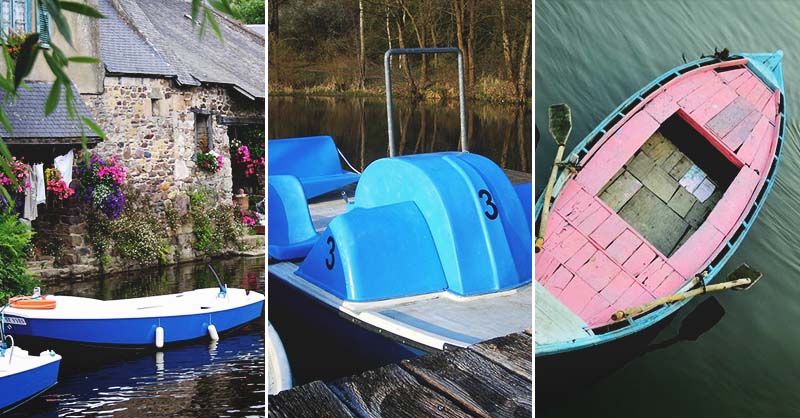
Do you enjoy spending a day out on the water every now and again? But does your budget allow you to purchase a new boat?
Well, even if you’re working on a meager budget, you could still own a boat. “How?” you might ask.
Rather simply in fact… make your own. I probably wouldn’t have thought of this idea either until a few months ago when my husband developed the itch for a boat.
He traded for a boat with a title, but it didn’t run. We’ve spent quite a few dollars and hours into making it work, and now we have a decent boat to enjoy on the water.
If you aren’t into fixing something up, I’m going to bring you some of the internet’s best ideas for making your own DIY boat. Here they are:
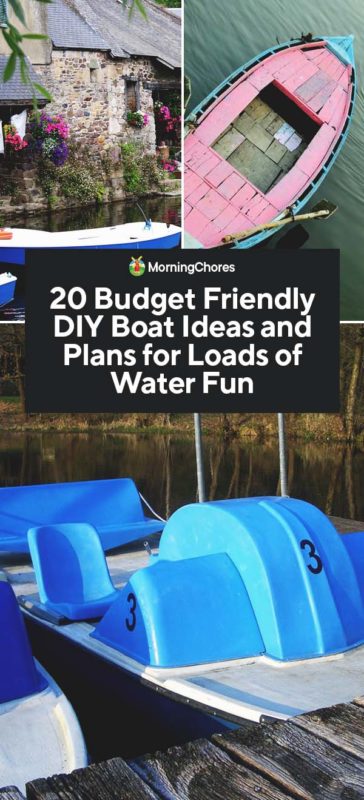
1. The DIY Tiny House Boat

We’re going to jump right in with a doozy to choose from. If you’re in the market for not only a boat but a houseboat, you may be wondering if this could ever fit in your budget.
Well, when you see this wood framed pontoon tiny houseboat , you’ll soon learn it can become a reality for you with a little hard work.
2. Basic Wooden Boat

Whether you need a small fishing boat or a smaller boat to paddle around a pond, these plans are great for either.
The plans for this boat walk you through each step of the process. If you’re a beginner in the world of carpentry, this boat could still be feasible for you.
3. PVC DIY Kayak

I wasn’t aware of how expensive kayaks could be until our oldest recently caught the urge to purchase one. Suddenly, I realized how much money a person could invest in one.
However, this kayak appears to be quite buoyant and should be quite a bit cheaper because it’s constructed from PVC pipes . How neat does it look?
4. Recumbent Pontoon Pedal Boat

Do you enjoy renting a paddle boat and heading out on the water? Then you’ll love this boat. It’s a DIY version of a paddle boat.
However, it has large floats on the side which makes it a smaller version of a pontoon boat . Also, it’s made to recline for a more relaxing ride.
5. Plywood Canoe

Canoes are a fun way to go up and down a river or other smaller bodies of water. If you’d like to have one, consider building it.
You can use these plans which show you how to construct a canoe out of plywood. This should make it more affordable yet functional too.
6. DIY Pontoon Boat

Pontoon boats are amazing boats to own. They’re great for fishing and luxurious enough to be a comforting way to cruise the water on a gorgeous day.
If you’d like to own one but can’t afford to buy, consider using these tips to help you build a pontoon boat all on your own.
7. Flat Bottom Boat Plans

One thing I’ve learned over the past few months of renovating a boat, is you don’t need anything fancy for a fishing boat – unless you want it to be fancy.
However, if you’re in the market for something simple and functional, the plans for this flat-bottomed boat should do it.
8. PVC Johnboat

A Johnboat is a great way to get out on the water and have lots of fun. They’re also functional enough to make a nice fishing boat too.
Either way, if you’re in the market for a fishing boat, consider building your own johnboat with these plans.
9. DIY Simple Wooden Boat

This option doesn’t come with plans which I could find. However, it could still be used as inspiration for building your boat.
Again, these boats would be good options if you’re someone looking for an inexpensive way to go fishing.
10. Homemade PVC Raft

This PVC raft is another option which doesn’t come with plans, but it looks simple enough to build. If you have experience in carpentry, you should be able to figure it out rather quickly.
However, this looks like a fun way to get the whole family out on the water uniquely and cost-effectively.
11. The DIY Pontoon Double Hulled Kayak

This pontoon boat is built in an abnormal but intriguing way. Instead of having typical floaters on the bottom of the boat, they used kayaks.
From there, the rest of the boat was built of foam insulation and PVC pipe. When you get creative, you can build a boat with little expense.
12. The Fishing Punt

This is another cost-effective option for a fishing boat. However, there’s no guesswork on this one. The plans are laid out and easy to read.
Whether you’re an experienced carpenter or someone who has recently begun to build things, this could be a viable option for you.
13. Inflatable Raft Fishing Boat

Are you struggling to come up with enough room in your budget to build a new fishing boat? What if you could use your inflatable raft as a boat?
Well, thanks to this idea, you can. The person who created this put a plywood bottom in a raft and turned it into an amazing little fishing boat for little money.
14. Single Plywood Boat

If you don’t need a larger boat, this could be the answer for you. It’s cost-effective because the whole thing is built from one sheet of plywood.
Even though this boat isn’t the biggest, it would make a great fishing boat for a one-person fishing trip .
15. Zip Tie and Ply Mini Boat
If you’d like to get out on the water for a fun day of fishing or sight-seeing, consider building this unique mini-boat .
It’s made from zip ties and plywood. Though it may sound a little sketchy on the surface, it seems quite buoyant and inexpensive too.
16. The Homemade Pontoon

When I saw this boat , I instantly sent it to my husband and said, “Can you build this? I may need it a little bigger to fit the kids and dog on board.” This should tell you; I love it!
But it actually is a cool idea. It looks comfortable for both cruising and fishing. Plus, it should be possible for most budgets.
17. PVC Pontoon Boat
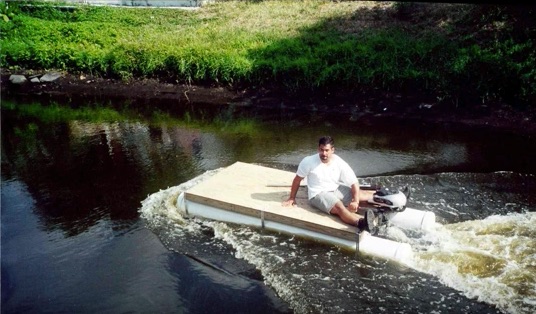
Some of you may be looking at these ideas and saying, “This is great, but I’d prefer to have a motor attached to my boat.”
Well, you’re in luck. This pontoon boat is easy to build and also shows you how to attach a motor to keep you from having to paddle everywhere you go.
18. The Micro Houseboat

If you’ve ever searched for a houseboat, you know how expensive they can be. But don’t give up on your dream yet.
Instead, look into building this tiny houseboat . It has a gorgeous interior and would make a great full-time home or a small vacation home.
19. DIY River Raft

Who says you have to build something overly complicated to enjoy a day out on the river? Well, you don’t.
Instead, build this simple raft . It’s constructed from PVC pipe and has a few seats add onto it. It looks buoyant and can help you to have many enjoyable days out on the water.
20. Seafoam Kayak

Would you like a light-weight kayak you can build yourself? Consider creating this kayak made from sea foam.
It only weighs 16 pounds and is built to be eight feet long. This could be a great way to enjoy many days out on the water without much fuss.
Now you have 20 different options for a DIY boat. You can choose between kayaks, johnboats, houseboats, tiny homes, pontoons, and much more.
We hope you’ll find something on this list to inspire you and be able to create something you can enjoy all summer long.
Was this article helpful?
What went wrong.
This article contains incorrect information
This article does not have the information I am looking for
How can we improve it?
We appreciate your helpful feedback.
Your answer will be used to improve our content. The more feedback you give us, the better our pages can be.
Follow us on social media:
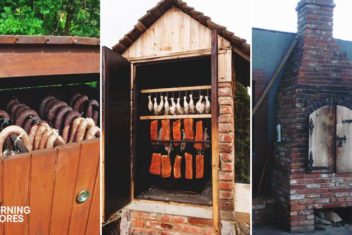
23 Awesome DIY Smokehouse Plans You Can Build in the Backyard
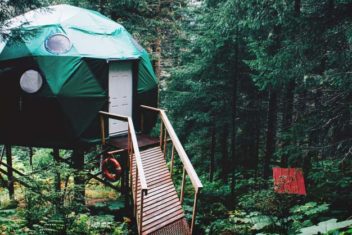
30 Geodesic Dome Ideas for Greenhouse, Chicken Coops, Escape Pods, and More
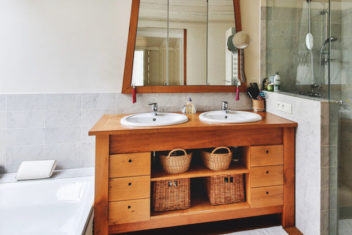
15 Beautiful Makeover Ideas for a Snazzy DIY Bathroom Vanity
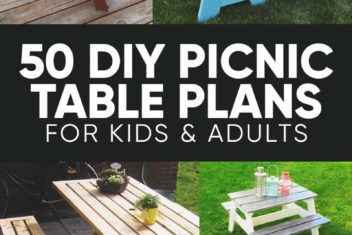
50 Free DIY Picnic Table Plans and Ideas that Will Bring Your Family Together
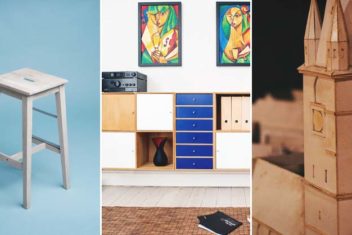
26 DIY Cardboard Furniture Ideas That Are Surprisingly Practical
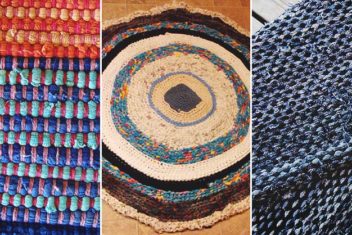
30 Unique DIY Rag Rug Designs So You Can Create Your Own

How to Build a Sturdy Wattle Fence with Tree Branches
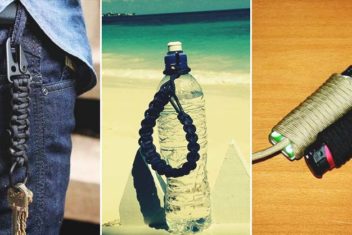
23 Ingenious Paracord Projects You Can Make This Weekend
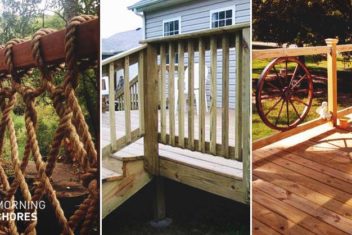
32 DIY Deck Railing Ideas & Designs That Are Sure to Inspire You

34 Unique DIY Bath Bombs to Enjoy Bathtime Like Never Before

27 DIY PVC Pipe Project Ideas That Are Actually Useful

18 Nourishing Homemade DIY Lip Balm Recipes for Beautiful Sweet Lips
Spotlight Airplane
Spotlighting lets you share this airplane with all of your followers. This is a great way to help new players get the recognition they deserve for their work.
Click the Spotlight button below and all of your followers will receive a notification.
Download Airplane
If you are on Mac, copy this airplane ID to the clipboard and press CMD+L while in the designer in SimplePlanes to download this airplane.
If you are on mobile, then try requesting the mobile version of the site. You can learn more about how to do that here . Otherwise, just click the Download for Mobile button below.

Simple sailboat Use Trim for foresail control, and VTOL for main sail control Boat behaves best at around 50-60 mph wind speed
Be careful when gybing at low speed (below 18 kph). The boat might stop during the maneuver, and you may be stuck drifting backwards with the wind. If that ever happens, ease the main sail, trim the foresasail, and wait till the boat recovers.
Specifications
- RekamtihGaming 9 months ago
- 210100 9 months ago
- Bryan5 9 months ago
General Characteristics
- Created On Android
- Wingspan 6.6ft (2.0m)
- Length 20.8ft (6.3m)
- Height 22.7ft (6.9m)
- Empty Weight 5,811lbs (2,635kg)
- Loaded Weight 5,811lbs (2,635kg)
Performance
- Wing Loading 9.1lbs/ft 2 (44.6kg/m 2 )
- Wing Area 635.7ft 2 (59.1m 2 )
- Drag Points 2825
- Number of Parts 66
- Control Surfaces 0
- Performance Cost 253
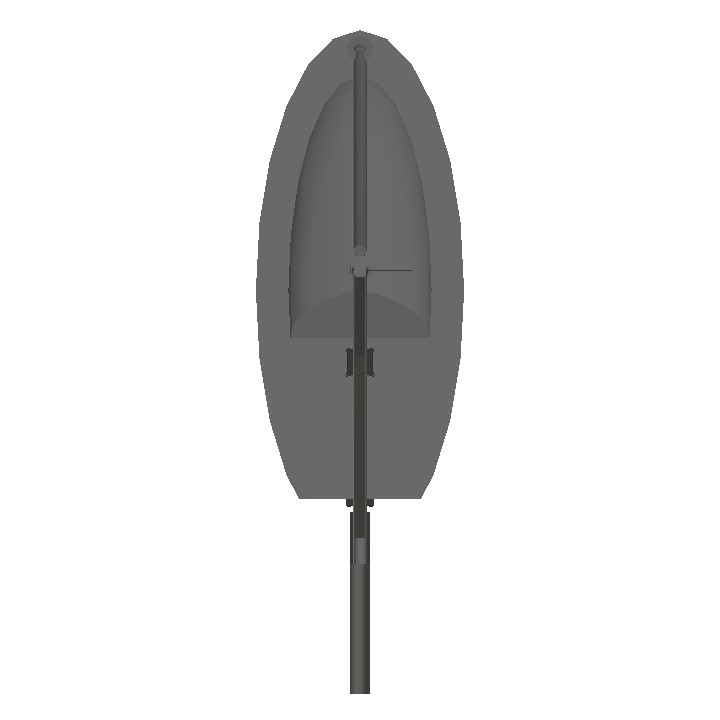
- Log in to leave a comment

IMAGES
VIDEO
COMMENTS
Know how: Build Your Own Boat. There's nothing like a simple boat with a simple rig and the simple joy of having built her yourself... Not many events in life are as emotionally convoluted as when the plans for a sailboat arrive at the amateur builder's home. The plans flutter out on the dining table and quickly there arise intertwining ...
Sailboats that you can build from home will likely be a small boat under 20 feet. These could be from many different boat suppliers such as B&B Yachts, Brooks Boat Designs, and Chase Small Craft. Boat plans will vary based on your budget and how much time you have on your hands. Based on my previous experience, building your own boat will take ...
To guarantee a smooth sailing experience, follow these steps: 1. Carefully inspect the hull of the sailboat for any damage or cracks. Be sure to check the seams and joints thoroughly. 2. Take the time to check the rigging, including the mast, shrouds, stays, and halyards, for signs of wear, fraying, or corrosion. 3.
When building a wooden sailboat, it is important to pay attention to every step, including the installation of the cabin and interior features. To install these features, follow the following steps: 1. First, measure and cut the materials for the cabin walls, floor, and ceiling. 2.
To download these plans, click HERE The Drifter 12 L is a higher performance version of the Drifter 12, with longer amas, and a taller mast. It can be paddled or sailed with as simple rig using a windsurfing mast. The sail rolls up, and is reefable...
Idea 21 small sailboat plan is the latest development of my family of small plywood & epoxy sailboats plans for homebuilders: it was quite a time since I was thinking of an evolution of her smaller 19 footer sister, so I finally take the decision to publish this new plan. The goals of this plan is simple: add interior volume, simplify the work for homebuilders switching to a complete plywood ...
A homebuild wooden boat plan - but simple to build and fast. The result is that this traditional-looking sailing skiff is lighter than many racing dinghies. Peter's Gruff weighs in at a very light 127lbs (58kg). Not bad for a boat a little under 16ft (4.8m). A geographic/historical advantage of Australian and NZ boat design and construction.
BOAT PLANS & FULL SIZE PATTERNS - Package Includes latest sail boat plans, SAILBOAT building plan updates & revisions, PLUS direct contact with the designer. This design is for those that want a fast cruising sailboat and one that can accommodate the family or a racing crew and is a joy to sail as well as being easy to build in a variety of ...
25 Steps to Building Your Own Stitch-and-Glue Boat. George Retseck. 1. | Procure a set of plans, or scaled drawings of what you're going to create. Devlin creates plans for hundreds of DIYers ...
Build Your Own Boat (DIY) and Save Bruce Roberts sailboat designs & boat plans. This section of Bruce Roberts sailboat designs and boat plans cover the following vessels. The Roberts, Adventurer, Tom Thumb, Spray, Canoe Stern, Classic, Henry Morgan, Power Cat, PCF 36-40, Mauritius/Norfolk, Offshore, Trader and the New York series.
After a short break, Lou is back at it! 23' V-Bottom sea trials and new ORCA episodes on the way but first we want to share with you a great video from our ...
Find the highest quality sailboat plans here---complete with illustrated step-by-step instruction manuals! Sailboat plans for our earlier designs are on 24" x 36" paper; parts that fit within those dimensions are shown full size. Other components are scaled and dimensioned. Our newest sailboat plans are rendered with all parts shown full-size ...
Boat plans 30 - 40 ft. This section of Bruce Roberts sailboat designs and boat plans cover the following vessels in the range of 30 to 40 foot. The Roberts, Classic, Henry Morgan, Offshore, Power Cat, PCF 36/40, and Canoe Stern designs. Boat building plans using steel, aluminium, fiberglass wood/epoxy, dependant on the design, are available.
Here you can download the first part of the plan in A4 PDF format . With this you already have the complete boat. Based on the construction photos, there's not much missing to build the whole MiniX. But since we're taking care of you, here are the sail plans too: Jib plan ; Mainsail plan ; Real sails with webs for their shape. The construction ...
Aluminium or steel long range swing keel cruising yacht. Samoa 28. Light displacement comfortable cruiser-racer. Pop Alu 28. Unlimited ocean aluminium cruising yacht with twin bulb keels. Pop Star 21. Trailerable boat for high performance and versatile day sailing. Pop 20. Cheap and easy to build boat for coastal sailing.
Sailboats. Sailboats embody the mystery of the sea, of going only where the wind is willing to take you. We offer a variety of sailboat sizes, using several construction techniques. We offer sails, hardware and rigging for many of our sailboat designs. This enables you to focus on building your boat, not searching around for all the bits and ...
How to Build A Sneak Boat - Kara Hummer Plans. 3. Know how: Build Your Own Boat - Sail Magazine. 4. Build a 7.5ft Boat with 2 Sheets of Plywood. 5. Build your own 12′ X 4′ Simple Aluminum Boat - Boat Design Net. 6. DIY Foldable Boat for Only 30$!
This boat has a small cockpit and can be controlled easily by a single person. The large sail plan of the Lateen-Rigged Sunfish makes for excellent performance in light winds and amazing speed on windy days. The Sunfish is a lightweight fiberglass boat with a simple rig and is a great step-up from a sailing dinghy.
Free Boat Plans The plans offered here are free public domain boat plans. Cabin Cruisers Caballero Flight Dolphin Eager Eve Ha'Penny Ranger Sea Angler Sea Babe SeaHawk Whizz Sportsman Canoes and Kayaks Blue Bill 13 Canvas Back Canvas Kayak for Junior Glide Easy Hunting Kayak King Canvasback Pintail Little Chief Plyak Fishing and Utility Buddy […]
Free Boat Plans You Can Build This Week (with PDFs) 1. The Wanigan. PC Duckworks Boat Builders Supply. The Wanigan boat began as a garvey design, which is one of the older boat plans known to the Americas. Traditionally, these boats were built as work scows and were very popular among American summer camps.
Buy Canoe Plan - $75. Light and lovely to paddle. Simple Plywood Boat Plan. Light on the land, Prettiest Plywood or wooden Canoes anywhere. 15.5ft. Excellent distance touring boats. 15'6″, simple construction for a wooden canoe. 32 - 45lbs (15 to 20kg) Click here for a comparison between our paddling canoe plans.
15. Zip Tie and Ply Mini Boat. If you'd like to get out on the water for a fun day of fishing or sight-seeing, consider building this unique mini-boat. It's made from zip ties and plywood. Though it may sound a little sketchy on the surface, it seems quite buoyant and inexpensive too.
Simple sailboat Use Trim for foresail control, and VTOL for main sail control Boat behaves best at around 50-60 mph wind speed. Be careful when gybing at low speed (below 18 kph). The boat might stop during the maneuver, and you may be stuck drifting backwards with the wind. If that ever happens, ease the main sail, trim the foresasail, and ...